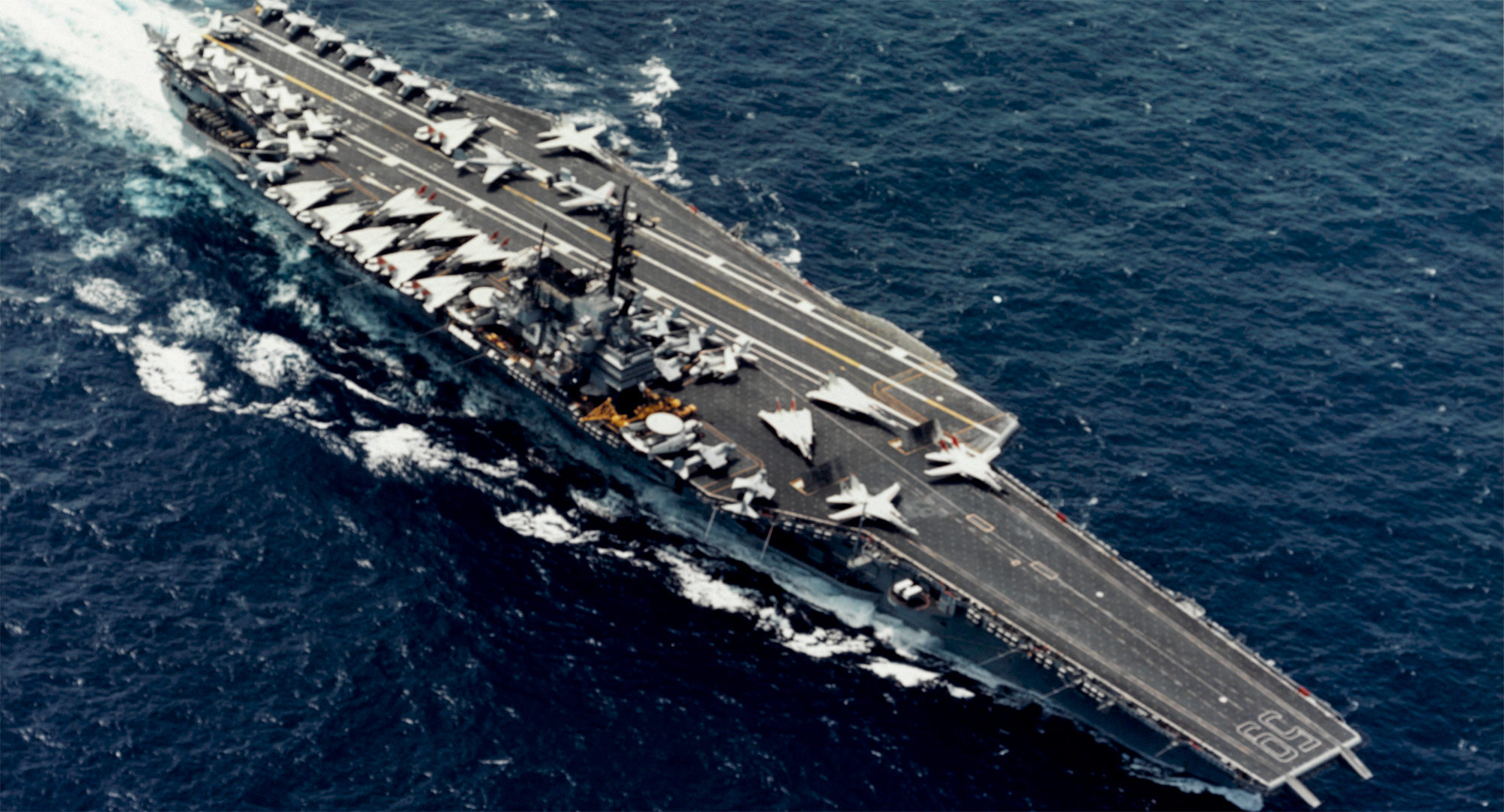
Forrestal class Aircraft Carriers (1954)
 USS Forrestal, Saratoga, Ranger and Independence (1954-57)
USS Forrestal, Saratoga, Ranger and Independence (1954-57)
Cold War USN Carriers:
Essex SBC-27 class | Saipan class CVs (1945) | Midway class | USS United States | Forrestal class | Kitty Hawk class | USS Enterprise | Nimitz class | Gerald Ford classAssault Carriers:
Iwo Jima class | Tarawa class | Wasp class | America class | SCS class | VSS classThe Forrestal class aircraft carriers (CV-59-62) were the first USN “supercarriers” of the USN, tailored to carry the generation of jet fighters. With the last commissioned in 1959, they served for the whole cold war, missing Korea but seeing Vietnam and all the crisis and modern conflicts on all seas and oceans. Decomm. from 1993, they were BU in 2014-17.
Design Development
The USN admiralty knew as soon as the keel of USS Midway was laid down in late 1943, that a replacement class was to be provided. However apart assuming the class would be armoured, which reached a consensus, and larger to accomodate a mix of jet and piston-powered models in development stage, there was no futher detailed studies, at least before the end of the war. The staff just wanted to see how the new Midway class would fare in service before precising any requirements.
Carrier-borne Nuclear Strike
Thus, as soon as USS Coral Sea was completed and commissioned on 1 October 1947, with a slightly revised design compared to CV-41, design studies resumed, although by that stage, the focus was on a new, very large -in fact a first “supercarrier”: The USS United States class (CVA-58). This basically was a Navy response to the Air Force, that monopolized nuclear strike at the time, to provide the USN a carrier-borne deterrent capability, and not lost prestige and budget. However the inter-service rivalry in peacetime led to its cancellation (LeMay’s SAC prevailed), as soon as the first plates were laid in 1949.

Navy Dept. early artist impression/concept art for CV-59 NAN 11-52 (1951). Note the two elevators and two angled flight decks, absence of island.
The aftermath led the USN to choose a more conventional design, with the hope that in the long run, they would eventually carry aircraft large enough (and the authorization) to also have this nuclear strike capability (which eventually happened in the 1960s). It should be said that tests were performed onboard the large Midway class, quite soon, to launch (but not recover) modified biprop PV-2 Neptunes fitted with rocket assisted launch systems, and a payload correponding to the current Bomb A models. These tests proved sucessful, but this was no more than a reboot of the Doolittle Raid. In no way the PV-2 could be accomodated on board on a regular basis and there was nothing in the USN inventory that fit the bill to carry nukes at the time, and small enough to fit in.
The CV-59 was the first major aircraft carriers designed since the Mid-winter 1947, partly resuming studies conducted with the USS United States, incorporating an island but smaller in size the Senate specified a tonnage of less than 60,000 tons.
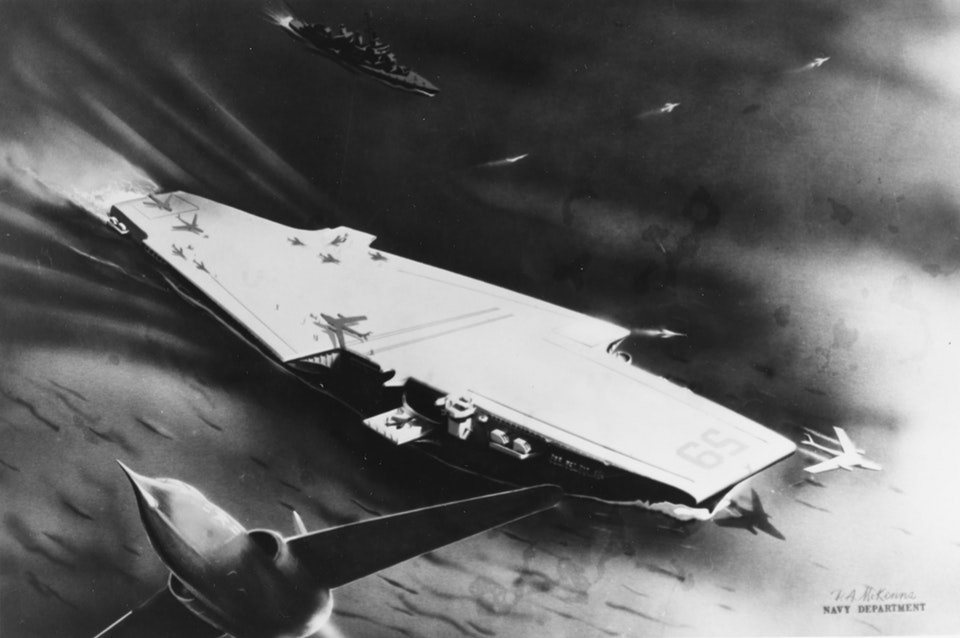
Navy Dept. early artist impression/concept art for CV-59, original configuration (1951)
The Aircraft Carrier CVB-59, as depicted by D.A. McKenna, showed the original, and first design. After many modifications, the final design incorporated many lessons from the Korea war, even when she was in already construction: The island and broader flight deck, repositioned lifts, redefined air operations, for a permanent cycle of simultaneous landings and launchings, plus changed linked to new heavier jets and extra avgas storage. As originally planned, the 1951 design had catapults at the bow and on sponsons on either side. The landing area was on the centerline and like for the USS United states there was no proper “island” but a very small tower. This art was shot and kept at the Naval Photographic Center on 27 September 1951. Official U.S. Navy Photograph National Archives coll. on navsource.org. Forrestal was indeed initially designated CVB-59 (“B” standing for Big), but it was changed to CVA-59 (for “Atomic”) on 1 October 1952 prior to commissioning.
Detailed design
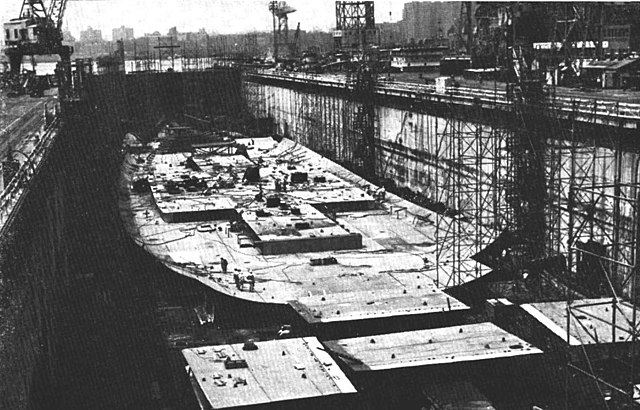
CVA 62 under construction July 1955, note the protecting extra plating bulging over the machinery section at the center of the ship at that stage.
The first “supercarrier” were named that way due their then-extraordinarily high tonnage of 75,000 tons, which was 25% larger than the Midway class, or three times USS Ranger (CV3), fully loaded. As massive as they were, they still derived from the 1945 post-Midway design studies not fully integrating lessons of the war in terms of air group management. Thus, like the Midways, the project SCB 80 (Forrestal and Saratoga) were first designed and built with straight deck, for potential “sunday punch” style full deck launches. It’s only later that an angled deck was integrated in the design. If Forrestal and Saratoga were laid down as axial deck carriers, they were completed with an angle deck, while USS Ranger and Independence were laid down as angled deck carriers from the start, but with various minor improvements.
Another difference with the Midways, they were designed with a tall and large island integrating the funnel in a more rational way. The bridge was triple, with two enclosed full size ones, for the CO, XO and wing command above, plus the admiralty bridge and open bridge on top. It supported large aerials and antennae for all around long range air and sea surveillance, completed by it’s own air group. Ironically this island was not even planned in their initial design:
Indeed like the USS United States, they featured a very small and retractable island. But like for the Unites States, this solution caused a lot of problems. The raising mechanism for it was searched for but still not ready when the decision was made to add an angled deck. Also and smoke fouling of the deck, in a side funnel configuration, was expected to ruin aicraft operations depending on the wind. The angled deck solution enabled to fite a large island and it’s funnel, bringing more flexibility, notably for command and control in air operations. Never the idea of a island-less configuration was discussed again and all follup designs adopted a comparable island. At least for eight ships as the USS Enteprise, planned since 1956 with a nuclear propulsion, got rid of the funnel and instead gained a powerful multifunctions radar.
The main difference between the Forrestal-Saratoga pair and the Ranger-Independence was that the first were completed with two island masts and an open fantail plus larger flight deck segment forward of the port aircraft elevator versus a single island mast closed fantail, smaller flight deck segment forward of the same port aircraft elevator, allowing a larger mid-ship flight deck section and more parking space.
Hull and Protection
That sounds surprising for the cold war and to us today, the very modern, post-WW2 CV-59 class was designed as armoured carriers, differently from the Midways. However as the design progressed, armour was toned down to the essentials and active proection measures were beefered up instead, but with a system very sumilar to the British Aircraft carriers. Their large size required a deep-hulled design incorporating the armored flight deck for the first time into the hull, no longer as a superstructure.
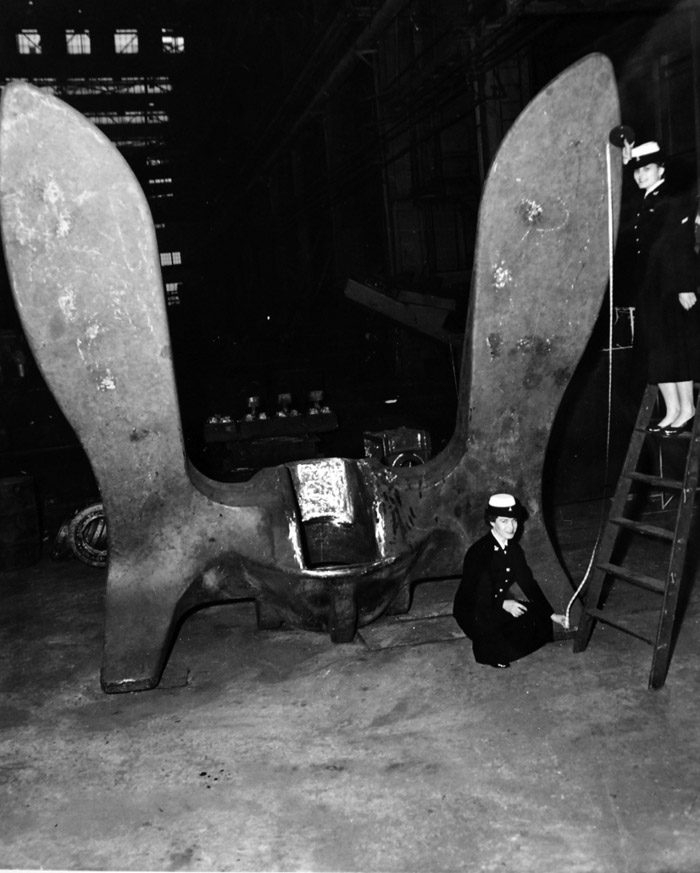
Blades of the largest anchor ever built by the U.S. Navy, 12 feet long, in scale with by WAVES Storekeeper Seaman Frances Gand (kneeling) and Seaman Apprentice Iris Mae Bixby at the Norfolk Naval Shipyard Foundry, Portsmouth, Virginia. National Archives coll.
This structural originality grew out of the requirement to carry the strength deck at flight deck level for a stronger and lighter hull and this allowed engineers to not be concerned for stability as they were for the Midways, criticizes as to be too low and always wet in heavy weather. The deeper hull Forrestal class gave them extra freeboard, better seakeeping and less trouble operating for their onboard aviation. They still kept a complete belt amidship, 6 in thick (150 mm), combined with a flight deck 1.8 in (45 mm), a gallery deck 1 in (25mm), hangar deck 1.45 in (37mm), and main deck 1.45 in (37mm) creating a four layered defense in STS steel, while the belt was completed by a backup torpedo bulkhead 3 in (76 mm) thick.
This new protection became a critical issue, as said by Cracknell, W.H, in Warship Profile 15, “USS Enterprise (CVAN 65) Nuclear Attack Carrier, p.56: “The main armor carried on Enterprise is the heavy armored flight deck. This was to prove a significant factor in the catastrophic fire and explosions that occurred on Enterprise’s flight deck in 1969. The US Navy learned its lesson the hard way during World War II when all its carriers had only armored hangar decks. All attack carriers built since the Midway class have had armored flight decks.”
All in all, the new carriers reached the amazing size of 1063 feets overall, 129 in beam, and the largest ever flight deck width so far, 252 feets. Displacement was 60,000 tons nominal for USS Forrestal, in normal draught, but rose for her sisters and over time to 75,000 tonnes nominal for Forrestal fully loaded, then 75,900 tonnes after th angled deck was installed and up to 79,300 tonnes later in their carriers. They basically reached almost 80,000 tonnes, something unheard of for a warship. Only supertankers would surpass these figures.
Powerplant
Nothing revolutionary on that chapter. The Navy trusted their geared steam turbines, and in that case, it was scaled up for a 75,000 tons vessel, with four sets of Westinghouse geared steam turbines fed by 8 Babcock & Wilcox boilers, for a total output of 260,000 shp for CVA59 and 280,000 for the three others. This resulted in the top speed of 32 for the first and 33 for the others;
Why such difference ? Simply the boilers were of an older model on Forrestal and worked at a lower pressure. In fact, USS Saratoga was the first US carrier to use high-pressure 1,200 psi (8,300 kPa) boilers. This model was also adopted by her two next sister ships. All four carried the same amount of fuel oil, 8,570 tons, rising their endurance to 12,000 nautical miles at 20 kts cruise speed.
Flight Deck, Hangar and Facilities
CV 59 was originally designed as a smaller version of the cancelled United States, later revised after Senator Carl Vinson s’ decreed approving a 60,000 tonnes standard. The initial design called for a straight and flush or island-less flight deck, but with four catapults for simultaneous launches, two in the bow and one angled out from each side, in the waist. These catapults were of a new explosive type. Incidentally the stowage of catapult charges became major design problem as it did not resemble the problematic of deep buried ammo rooms. They were to be maintained close to the flight deck for obvious reasons.
The Forrestals were 100 feet (30 m) longer, 20 feet (6 m) wider abeam than the Midways, and even keeping a straight deck, they made a formidable aircraft platform, notably in rough weather and had the roomiest hangar decks, largest flight decks surface to date. All things aviators appreciated. In her final deck design, her very large middle flight deck integrated for the first time an angled deck forming a very wide theoretical parking area, although it was in practice reduced to the port side, close to the island and three lifts. USS Forrestal differed from the others by having her island placed closer to the bow.
The forward section was reserved for the two main C7 catapults (first two), far longer and more powerful than all previous classes, and completed by “lips”, whereas the two auxiliary C11 catapults were installed on starboard, in the end of the angled flight deck, but with another side elevator on the front. The next two ships only had four C7s, which became the new standard.
All four elevators were side models, and of the same size. Arrestors wires were installed aft, where the very large rectangle formed by amidship section of the main deck was reduced to fit the stern. In any case this made for a very roomy deck, which configuration was repeated for the next classes, but certainly not the best configuration yet, this was a first try.
Indeed, their elevators were badly arranged, with a portside elevator inherited axial-deck design located right into the path of the angled deck and secondary catapults, so in the launch path of any aircraft from these No. 3 and No. 4 catapults. The latter by the way were arranged close together, so as to only allowed successive launchings, not simultaneous unlike the N°1 and N°2 catapults. Nevertheless, they were unique as being the first to truly permit simultaneous takeoffs and landings.
The Kitty Hawk class had their portside elevator relocated to the aft end of the angle and the island and the second starboard elevator were swapped. This configuration indeed improving a lot aircraft handling. The CV 59 class with their roomier hull also carried a lot of avgaz and air ammunition (1,650 tonnes), 750,000 gallons avgas, even 789,000 JP5, far more than the cancelled (and larger) USS United States (500,000) and the previous Midway class (365,000).
Armament

Two of the eight turrets of the carrier USS Ranger firing, in 1961.
In 1950, gunnery was still the order of the day. Thus, they were armed with eight single 127mm/54 Mk 42, the new automated turret type designed to replaced the WW2 5-in/38 DP twin turret. Unlike the 5 in (127 mm)/54 Mark 39, and earlier model of which no less than fourteen were carried by the Midway class, in addition to ninteen quad 40 mm AA, the late 1940s had proven the virtues of new combined fuses with extremely precised fire control plus high rate of fire due to fully automatic reloading and aiming.
In 1952, when the ship were laid down, it was recoignised that new fighters pushed the envelope of protection far away from the ship and that with the new jets, all “light AA” guns were now obsolete, even the new twin 3-in/50 (76 mm) guns in service on many cruisers and destroyers in replacement for the 40 mm. There were talks of of these in additional sponsons, but the new promising jets and escorting missile cruisers led the admiralty grand designers to limit themselves to just two pairs of the new guns forward and aft in sponsons, allowing also to create their large, caracteristic flight decks in the process. As a “last resort defence” this was very acceptable, all weighted and also came with simplified armament management and supply, and a reduction of crew where it was really needed.
5-in/54 Mark 42 gun:
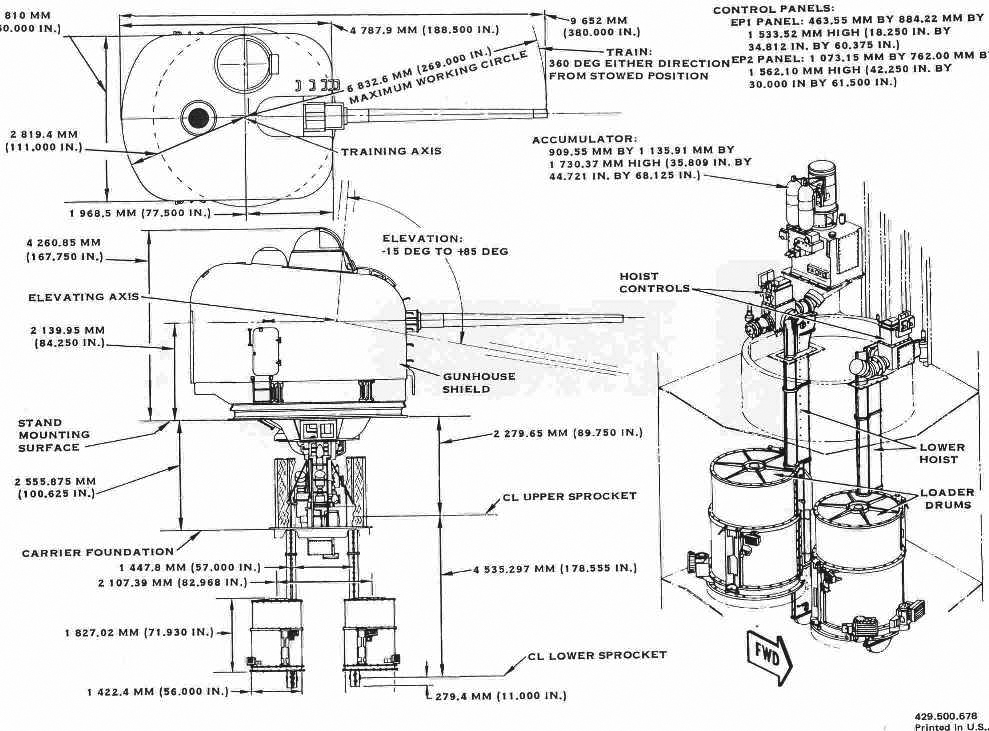
Here are the specs of the Mark 42 5″/54 Caliber Gun:
- Shell 127 x 835mm .R Conventional 31.75 kg (70.0 lb)
- Recoil 18.75 inches (476.2 mm)
- Elevation -15°/+85° at 25°/sec
- Traverse 150° at 40°/sec
- Rate of fire 40 rpm automatic (28 in 1968)
- Muzzle velocity 2,650 ft/s (807.7 m/s)
- Max range 25,909 yd (23,691.2 m) at +45° elevation
- Ceiling 51,600 ft (15,727.7 m) at +85° elevation
The Mark 42 5″/54 really was a cold war game changer for NATO. Not only it equipped cruisers, destroyers, frigates or the USN, but also was used by Australia, Egypt, Germany, Greece, Japan, Mexico, Spain, Taiwan, Thailand and Turkey, but it stayed in service amazingly well past the 1990s, staying relevant as long as the radar based firing control stayed relevant.
The sponson-mounted guns however suffered from poor range and complicated firing arcs, and were located in very wet and thus nearly useless positions in the bow and stern. They were removed after only a few years and were later replaced by missiles and much later by close-in weapon systems (CIWS). The aft guns in Forrestal lasted until the fire in 1967, then were removed and eventually replaced by missiles in the mid-70s.
Indeed, the forward sponsons fared poorly in heavy weather, reducing ship’s performances and splashing spray over the flight deck. Therefore, all four vessels only carrier their four aft guns, until Sea Sparrow mounts were generalized; It’s only in 1977 that the last of these traded guns for sea sparrows, with USS Ranger, which also retained her forward sponsons. Their stacks were also raised mid-life about 10 feets to accomodate larger arrays on Ranger and Independence.
RIM-7 Sea Sparrow Mk29:
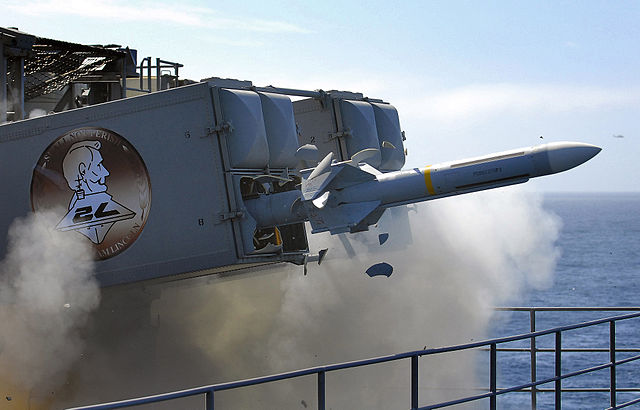
Well before SLEP, starting in 1973 for USS Independence and 1974 for USS Saratoga, two octuple Sea Sparrow SAM (16 RIM-7) were installed. 1976 for Forrestal, and 1977 for Ranger. In 1983 onwars, they were replaced on all ships by Mk.25 launchers. After SLEP refit, these were MK.29 launchers. The RIM-7 was a naval derivative of the short range air air missile AIM-7 developed from 1963 by Raytheon and General Dynamics. In fact when the Sparrow was abandoned in the air force for the AIM-120 AMRAAM, the sea sparrow went on in its development.
- Motor: Hercules MK-58 solid-propellant rocket motor
- Wingspan: 3 ft 4 in (1.02 m)
- Guidance: Semi-active radar homing
- Warhead: Annular blast fragmentation warhead, 90 lb (41 kg)
- Detonation system: Proximity fuzed, expanding rod 27 ft (8.2 m) span
- Speed: Mach 4+: 4,256 km/h (2,645 mph)
- Range: 10 nmi (19 km)
Phalanx 20mm CIWS:
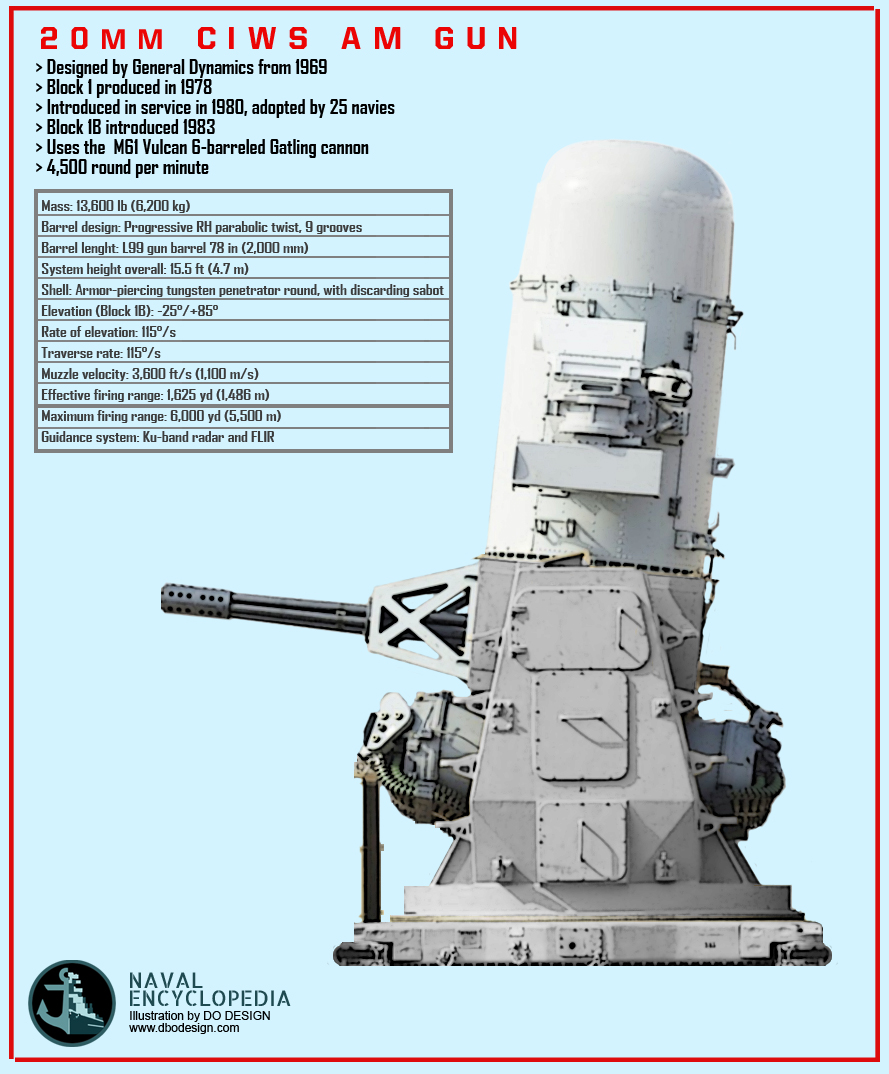
The first systems were installed on USS Saratoga in 1983: These were three 6-barreled 20mm/76 Mk 15 Phalanx systems. Ranger obtained them in 1985, as Forrestal, and Independence in 1988. The Phalanx CIWS were automated hyper-fast autocannons using a rotative barrel (Gatling system) to reach an exceptionally high rate of fire. It is designed to destroy an incoming missile’s airframe. Loosing its aerodynamic qualities while shrapnel secondary damage is a bonus to destroy potentially electronics systems. The key of the system is that it’s unmanned, but with human oversight. The tracking system is faster than the human brain can process the target acquisition. Another advantage of the system is that it can also destroy low-fliying aircrafts if needed or even deal with small and fast surface targets. Developed from 1969 and produced from 1978, it was constantly upgraded until today. The last system used on the Forrestal class were Mk.15 Block 1B which unit cost was US$416M. The data is for the Block 1B.
- Mass: 13,600 lb (6,200 kg)
- Barrel design: Progressive RH parabolic twist, 9 grooves
- Barrel lenght: L99 gun barrel 78 in (2,000 mm)
- System height overall: 15.5 ft (4.7 m)
- Shell: Armor-piercing tungsten penetrator round, with discarding sabot
- Elevation (Block 1B): -25°/+85°
- Rate of elevation: 115°/s
- Traverse rate: 115°/s
- Muzzle velocity: 3,600 ft/s (1,100 m/s)
- Effective firing range: 1,625 yd (1,486 m)
- Maximum firing range: 6,000 yd (5,500 m)
- Guidance system: Ku-band radar and FLIR
Electronics

USS Saratoga’s island radars in the 1980s
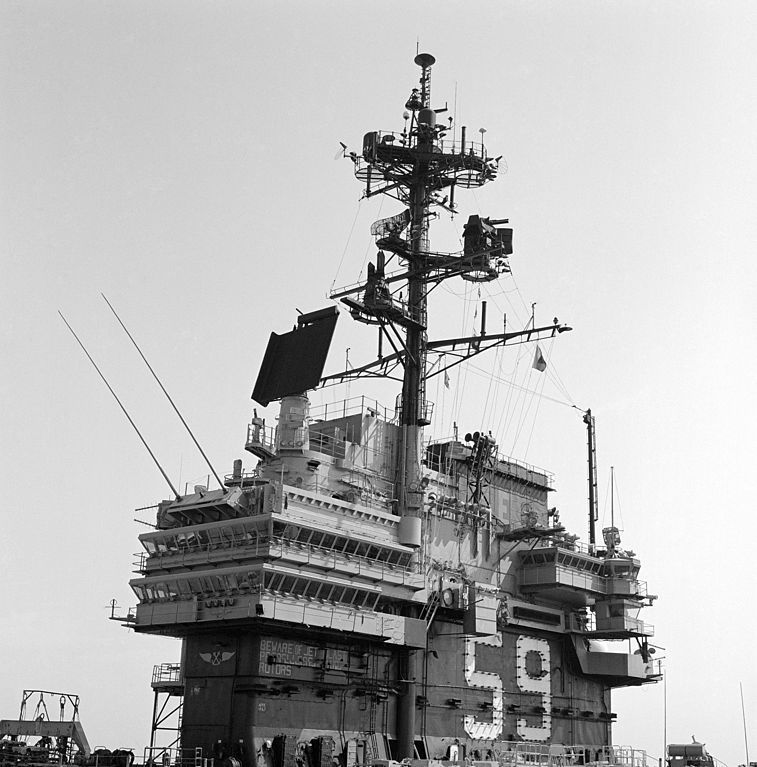
CV 59 island and masts
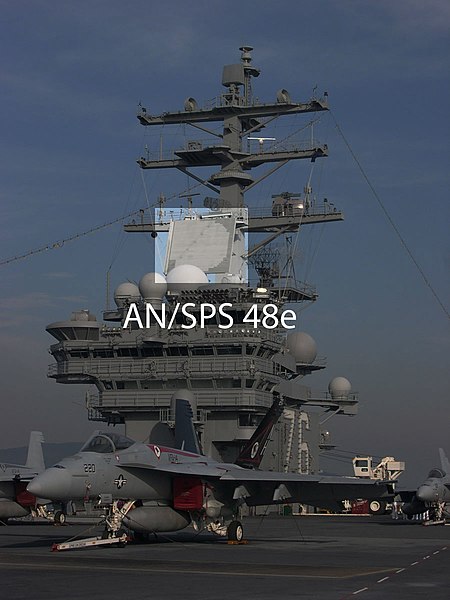
AN/SPS-48 3D air search radar: 17 ft (5.2 m) by 17 ft 6 in (5.33 m). Working on Frequency E and F band (2 to 4 GHz) at azimuth 360°, at a precision of 690 ft (210 m) 0-65° elevation, Range 250 nmi (460 km), Altitude 100,000 ft (30,000 m), powered by a 35 kW (avg). It is squarish in appearance.
The AN/SPS-48 2D air search radar was about the same. It is shared also by the Nimitz class.
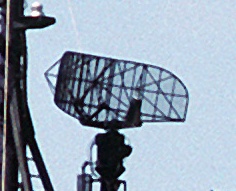
AN/SPS-10 surface search radar: An older (1959) 2D radar from Raytheon, using C Band at a PRF of 650 Hz on a beamwidth 1.9° × 16° and pulsewidth of 1.3 µs, power supply 280 kW. It was also shared by the Essex-class, Kitty Hawk-class and USS Enterprise and was really “Vietnam era” tech.
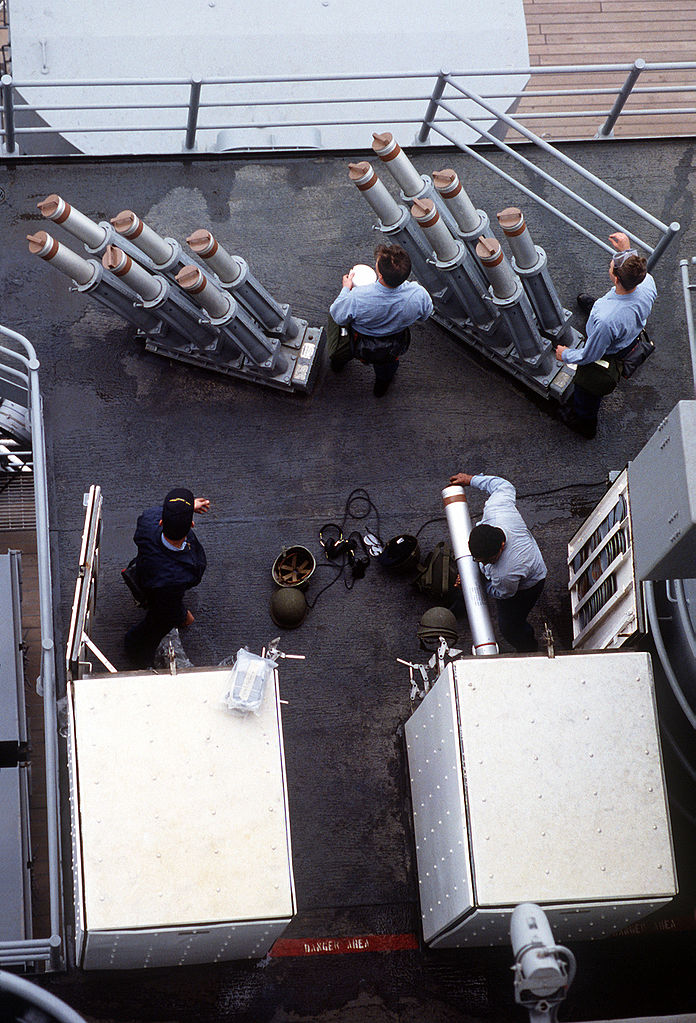
Mark 36 SRBOC: 1980s EW and decoys system, “Super-arboc” is a short-range chaff mortar also able to launch infrared decoys to foil anti-ship missiles. 2×3 tube racks at a 45°, 60° angle, for effective spread and defeat radio frequency emitting missiles. It was also tested with the TORCH infrared “flare” decoy system. Each shup so equipped carries 20-35 rounds per launcher in store. Still used as of 2010.
SLQ-29 EW radar: AN/SLQ-32 Electronic Warfare System (post-SLEP). This lens-fed multi-beam array generates very high jamming power at continuous wave.
WLR-1 ESM radar: The LR-1 is a shipborne radar warning receiver in service since the early 1960s, performing real-time intercept of signals, direction-finding, processing and evaluation of radio-frequency signal emitters in the 0.5-18 GHz (C to J) bands.
WLR-3 ESM radar: Radar warning and signal collection system.
WLR-11 ESM radar: Naval variant of the AN/ALR-52 ECM receiver, instantaneous frequency measurement (IFM) receiver for detection/analyzis of anti-ship missile threats. Standard radar warning system with an omni-directional and direct ion-finding antenna array, processor to emitt parameters from memory, bandpass filter for band rejection and pre-selection.
Forrestal class Air Group
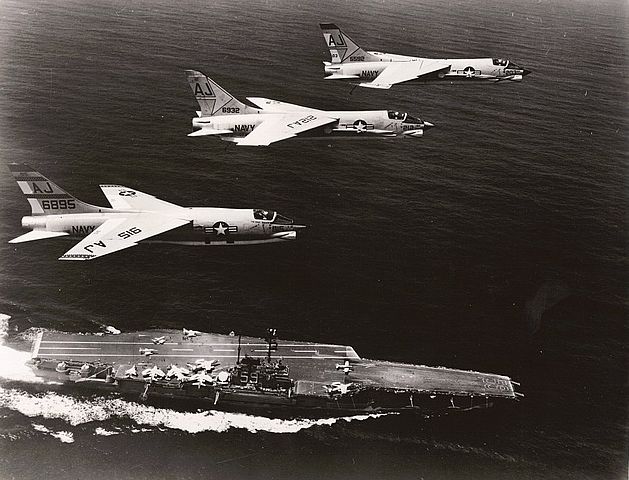
F8 Crusaders over USS Forrestal in 1962
Due to their very long active carrer, they would see virtually all the post-1944 generations of planes on her deck, from WW2 piston-engine to the models still actually in service on modern nuclear carriers. They started with an extremely strong air wing, initially planned (with the 1944 piston-engine generation, of 120 planes, and later down to 80–100 jet aircraft. It was “only” 65–75 for the Midway class and just 50 for the modernized 1950s Essex class, so double. Again, a good justification to call them supercarriers.
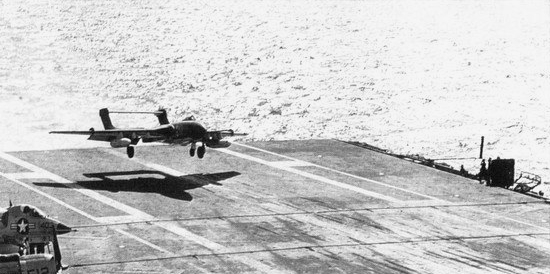
A Sea Vixen of FAW 892 NAS landing on USS Ranger in 1963. In addition to operating all models of the USN in the cold war, the carriers would at some occasion operate more unusual models, such as the C-130 (see below) or the Lockheed U2 (both for launch and recovery tests) and launching the B-25 Mitchell for a WW2 commemoration.
First air group

AD-1 of VA-85, USS Forrestal, 1958
As completed in 1955, USS Forrestal would have had 90 aircraft. a mix of F3H Demon, FG/F3A Skyhawk, , FJ Savage, F2H Banshee, F9F Panther, F3D Skynight, F7U Cutlass fighters, but also AD Skyraider, AJ Savage, both piston-engine attackers, F2H-P, F9F-P, AJ-P, OE, F7U-P recon planes, S2F ASW planes, AD-Q ECM planes, AD-W EW planes, TF cargo planes, HO4S, HRS, HUP, HO5S, HSL, HSS helicopters, for Forrestal alone in her whole career.
According to navypedia however, their planned air group in 1950 also comprised 14 F4U Corsair piston-engine attack planes (actually i found no reference of them ever in service in these carriers), a number of Grumman F7F Tigercat bi-motor long range fighter (same no clue) and the F8F Bearcat (same doubt here, no reference). All of these were allegedly retired in 1955-60 and it can find absolytely no photo or record of these ever been in service on the Forrestal or her sisters. The US Navy however the Douglas AD-1/A-1 Skyraider, their contemporary, with great success for many, many more years, in fact until the end of the cold war and full replacement by the A-7 Corsair II.
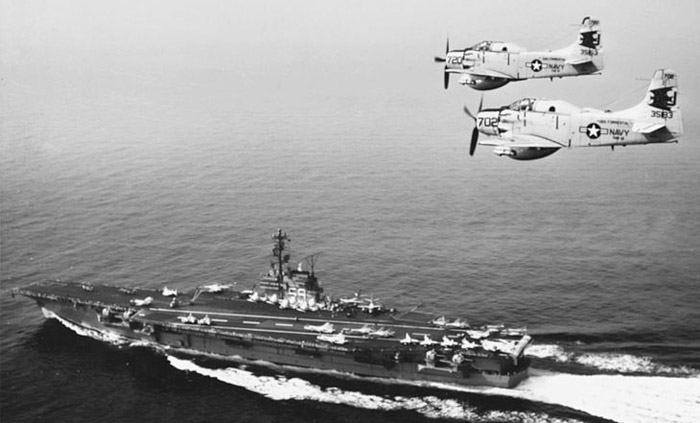
AD-5W Skyraiders (VAW-12) fly over USS Forrestal, 25 April 1960
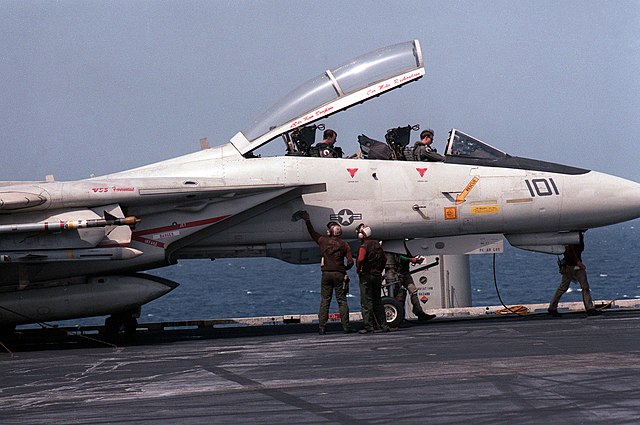
F14 Tomcat from USS Forrestal
In 1960, USS Saratoga operated the following:
-Fourteen 14 McDonnell F3H Demon jet fighters
-Fourteen F8U corsair fighters
-Twenty Four A4D Skyhawk light attack airplanes
-Twelve AD-6 Skyraider piston atack airplanes
-12 A3D Skywarrior large jet attack airplanes
-Four Vought F8U-1P phot-recce piston aircraft
-Four AD-5W Skyraider piston aircrafts for ASW warfare.
-Helicopters were operated but details are not known.
CVA59: 8 x 1 – 127/54 Mk 42, 90 aircraft (F4U/FG/F3A, F7F, F8F, FJ, F2H, F9F, F3D, F7U fighters, AU, AD, AJ attackers, F2H-P, F9F-P, AJ-P, OE, F7U-P recon planes, S2F ASW planes, AD-Q ECM planes, AD-W EW planes, TF cargo planes, HO4S, HRS, HUP, HO5S, HSL, HSS helicopters)
CVA60: 8 x 1 – 127/54 Mk 42, 90 aircraft (F7F, FJ, F2H, F9F, F3D, F7U, F3H, F4D fighters, AD, AJ, A3D attackers, F7F-P, F2H-P, F9F-P, AJ-P, OE, F7U-P recon planes, S2F ASW planes, AD-Q ECM planes, AD-W EW planes, TF cargo planes, HO4S, HRS, HUP, HO5S, HSL, HSS, HOK helicopters)
CVA61: 8 x 1 – 127/54 Mk 42, 90 aircraft (FJ, F2H, F9F, F3D, F7U, F3H, F4D, F11F, F8U fighters, AD, AJ, A3D, A4D attackers, F2H-P, F9F-P, AJ-P, OE, F7U-P recon planes, S2F ASW planes, AD-Q ECM planes, AD-W EW planes, TF cargo planes, HO4S, HRS, HUP, HSL, HSS, HUS, HOK, HUL, HR2S helicopters)
CVA62: 8 x 1 – 127/54 Mk 42, 90 aircraft (FJ, F2H, F9F, F3D, F3H, F4D, F11F, F8U fighters, AD, AJ, A3D, A4D attackers, F2H-P, F9F-P, AJ-P, OE, A3D-P, F8U-P recon planes, S2F ASW planes, AD-Q, F3D-Q ECM planes, AD-W EW planes, TF cargo planes, HO4S, HRS, HUP, HSL, HSS, HUS, HOK, HUK, HUL, HR2S helicopters)
The Vietnam War air group
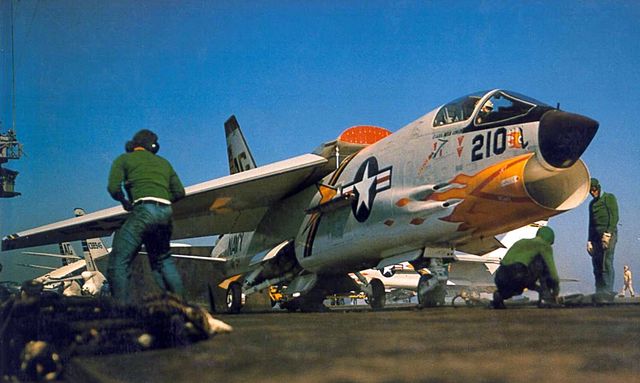
F-8C (VF-84) catapulted from USS Independence c1963
In 1967, USS Forrestal’s air grup comprised 24 F-4B Phantom II fighters-bombers, 24 A-4E Skyhawk attackers, 12 A-6A Intruder bombers, three RA-5C Vigilante, three RA-3B and three KA-3B Skywarrior, four E-2A Hawkeye for reconnaissance, surveillance, and electronic warfare and 4 Kaman UH-2A seasprite for SAR and ASW operations.
As the conflict ended in 1973, at least as far the US was concerned, the same USS Forrestal now had 24 F-4J, 24 A-7A Corsair, 12 A-6A, 3 RA-5C, 4 EA-6B Prowler, 4 E-2B, 4 KA-6D, 10 S-3A Viking and 8 SH-3H helicopters.
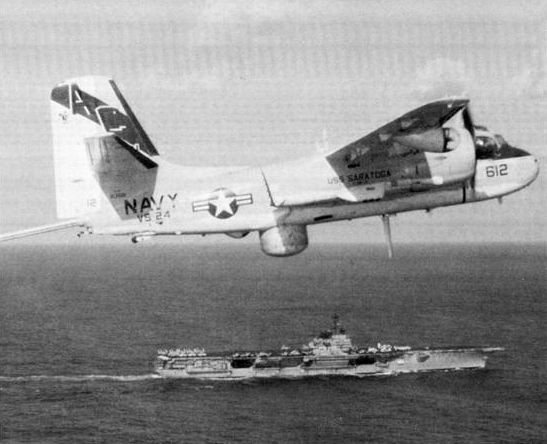
S-2G Tracker of VS-24 from USS Saratoga in 1974, first advanced warning dedicated model.
USS Forrestal, a record holder

Due to their large decks they operated some of the largest aircraft ever seen on a carrier, including some in principle forbidden on their decks like the very versatile 30 tons C-130 Hercules:
On October 1963 the US Navy indeed decided to try to land a Hercules on an aircraft carrier. It was done in moderately rough seas 500 miles out in the North Atlantic off the coast of Boston. In so doing, the airplane became the largest and heaviest aircraft to ever land on an aircraft carrier, a record that stands to this day. Full Article Video footage
These tests were highly successful, allowing a 85,000 pounds (39,000 kg) KC-130F to make on her deck a complete stop within 267 feet (81 m) at maximum load. The Hercules was also tested for takeoffs on 745 feet (227 m) and the Navy estimated she would lift 25,000 pounds (11,000 kg) of cargo and flew over 2,500 miles (4,000 km) to make this delivery on any carrier. Routine COD operations however would exclude it. It was more a what-if wartime scenario, an option to the general staff. Eventually the development of the Grumman C-2 Greyhound as a long range navy cargo plane in 1962-1965 made these tests no longer relevant.
The 1980s air group
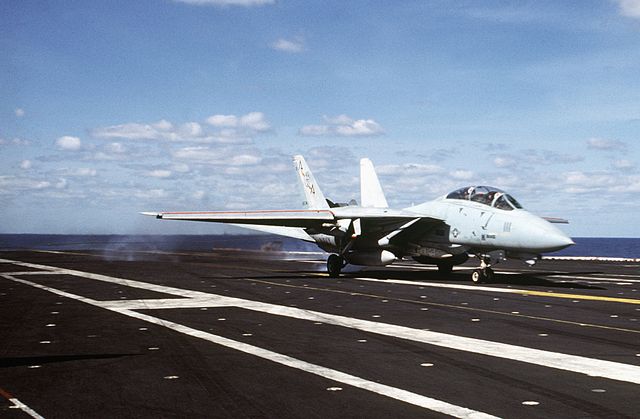
F-14 Tomcat landing on USS Saratoga in 1985
In 1987, USS Independence still operated 96 aircraft and helicopters:
-24 Grumman F-14A Tomcat (air dominance)
-42 Grumman A-6E Intruder (attack)
-Four E-2C Hawkeye (LR surveillance)
-Four EA-6B Prowler (Electronc warfare)
-Ten S-3A (ASW warfare)
-Four KA-6D Intruder
-Eight SH-3H Seaking SAR helicopters.
1990s air group
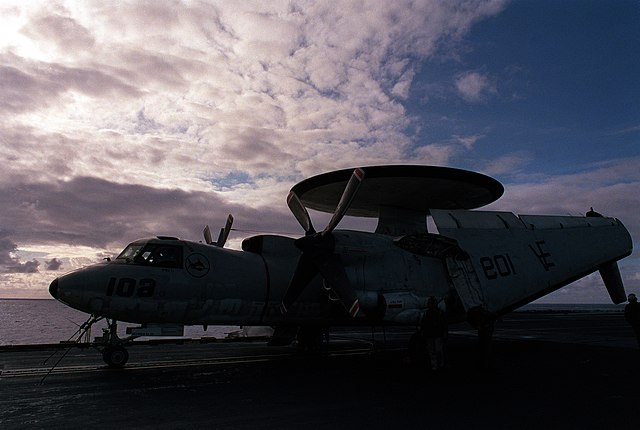
E2C Hawkeye from USS Forrestal
In 1998 the same USS Independence, the last decommissioned in 2004, was down to 76 planes and helicopters. Here is the detail:
-20 F-14A Tomcat Fighters
-36 F/A-18A/B Hornet Fighter/Bombers
-Four EA-6B Prowler EW planes
-Four E-2C Hawkeye LR surveillance panes
-Eight S-3A Viking ASW planes
-Four SH-60F Oceanhawk SAR helicopters.
About the crew and other specs
The Crew of a Forrestal class amounted to 3019 men for the ship’s company alone, and no less than 2,480 for the air wing, so a total of 5,500, also a figure never reached by any ship in the US Navy so far. In peactime the normal figure would be a bit less, 4,378 total combined. Nevertheless this was enormous. The previous Midways indeed reached 4,500, but many were assigned to the AA guns and lighter 40 mm mounts, plus the more numerous air park of the late 1940s and it was decreased over time. Not with their lower hulls, they were considered cramped and unpopular, unlike the much roomier CV-58 class.
Nevertheless, with the total combined crew of 5,500, expenses for such carrier, includung fuel, avgaz and food, was enormous yearly, on top of their base construction price, which was . for a annual operating cost in 1990 of $142,000,000 (source: FY1996 VAMOSC).
About the names
CVA-59 was named after James Vincent Forrestal (1892-1949). Formed WWI naval aviator veteran, first under Secretary of the Navy in August 1940, charged with the building of the world’s largest fleet ever. His brilliant work in procurement and production had him appointed 48th Secretary of the Navy in May 1944. He was appointed again by the first Secretary of Defense, in September 1947, resigned in March 1949. He passed away soon after.
For the next vessels, CV-60 USS Saratoga honored both the 1777 Battle, and interwar’s CV-3, second aircraft carrier of the Lexington class, just decommissioned after a very active and brillant WW2 career. CV-61 honored USS Ranger, CV-4 fist purpose-built USN aircraft carrier, and also WW2 veteran just decommissioned. CV-62 did the same, this time with the lead vessel, USS Independence, of the president’s CVL serie of WW2. Others in the class served a bit longer before decommissioned and they all added Korea to their WW2 records.
Construction
These four ships were started at Newport News and the New York Dockyard in 1952-55 and accepted for service in 1955-59, so there was a span of ten years before the first drafts in 1949 and the last ship commissioned. Nevertheless they well deserved their moniker of “super carrier”. They were indeed a monumental achievement, having to integrate four powerful catapults capable of launching the new generation of Navy jets, to store twice as much fuel reserves than the Midway class. Initially equipped with twin 3-in (76 mm) of the new AA standard, their platforms were troublesome foam generators in bad weather and they were later removed and replaced by Sea Sparrow launchers in the years 1972-77. During their long career spaning the entire cold war to its conclision, they underwent a serie of overhauls and reconstructions to stay relevant, from WW2 tech to the digital age.

USS Forrestal’s profile 1955 as completed

Forrestal’s profile in 1967, Vietnam war
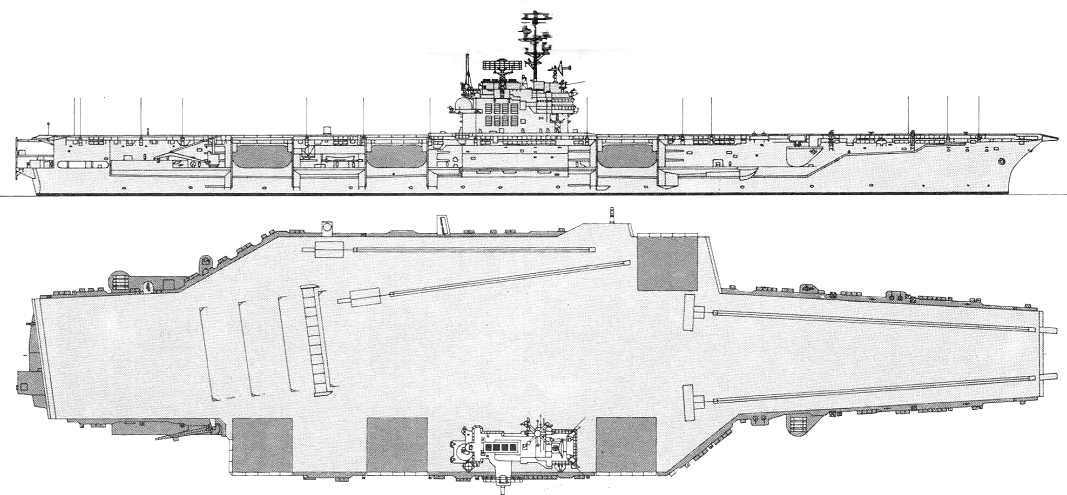
USS Forrestal in 1979

USS Ranger in 1975
⚙ Forrestal class specifications 1960 |
|
| Dimensions | 1,070 ft x 129 ft 4 in x 35ft 9in (316.7m x 76.2m x 10.3m) |
| Fight Dech | 1,069 ft 7 in × 252 ft 7 in (326m × 77m) |
| Displacement | 61,163t, 78,509t FL. |
| Crew | 2,764 + 1,912 (Crew, Air Staff), see notes |
| Propulsion | 4 GS HP turbines, 8 Babcock boilers, 280,000 hp (210 MW) |
| Speed | 34 knots (63 km/h; 39 mph) |
| Range | |
| Armament | 8x 5-in/50 AA, 75-90 aircraft |
| Electronics | SPS-8,10,12 radars, SPN-6,8,12, FCS Mk 35, SLR-2 ECM |
| Protection | Belt 6 in, flight deck 2 in, gallery deck 1 in, hangar and main deck 1.5 in, torpedo bulkhead 3 in |
Major Refit: SLEP 1980-88

Ranger in 1990
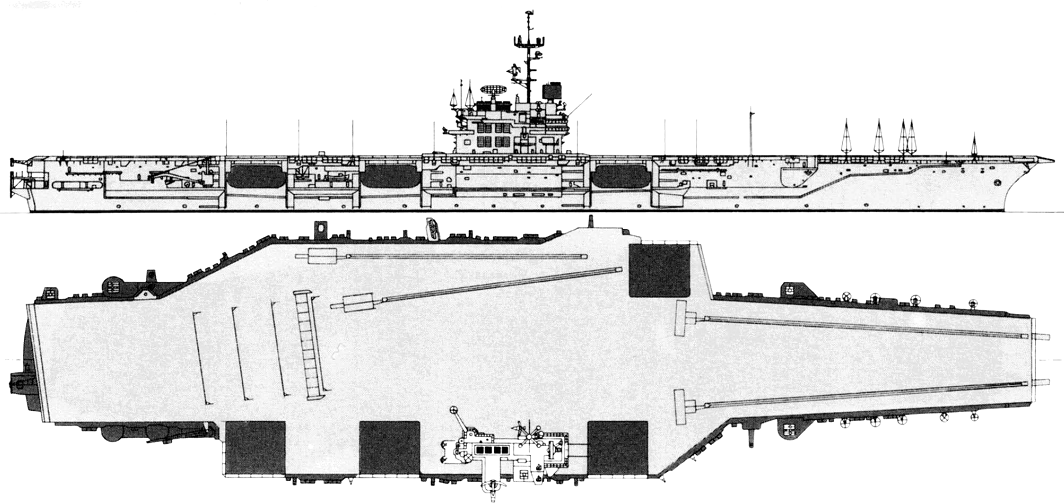
Saratoga in 1990
The early 1980s saw successively all four ships taken in drydock for their major Service Life Extension Program (SLEP), with Philadelphia as the first to be decomm. for her long refit 1s- Oct. 1980 to Feb. 1983, and November due to Boilers defects. Forrestal was next in 21 March 1981 to 20 May 1985, and then Independence in 18 April 1985 to Feb. 1988. Total cost was estimated to $550 million.
All major systems were overhauled, and new electronics fitted, such as the SPS-48C main radar, SPS-49, Better NTDS, Tactical Flag Command Center and Flag Data Display System. Kevlar was also added as extra protection for the C&C room and other sensitive areas. It was planned also to replaced their now old C-11/C-7 catapults by C-13s but this was postponed. The elevators however were reinforced to lift a 45 tonnes aircraft.
The defensive system was upgraded also: They gained Mk29 Sea Sparrow launchers with Mark 23 TAS, two directors per launcher; and three Phalanx CIWS anti-missiles.
USS Ranger did not underwent SLEP but was nevertheless extensively refitted in May 1984-June 1985, so in a simplified and cheaper way compared to the others. She had improved evaporators for her boilers, Halon, acqueous film firefighting system, Mk.23 TAS and three Phalanx.
The last modernized, USS Independence received the following modifications: Two octuple Sea Sparrow SAM (Mk 25 launchers) with 16 RIM-7, assisted by two Mk 51 FCS, and three 6-tubes 20mm/76 Mk 15 Phalanx. The SPS-29, SPS-30, SPS-58 radars were upgraded. She also had the WLR-1 and WLR-3 ECM suites and six Mk 95, Mk 23 TAS, SPS-48C, SPS-49(v)5, SPS-58, SPS-43A, SPN-44 for active electronics defense, three Mk 90 radars, and the WLR-1H, WLR-8, SLQ-17A ECM suite making the SLQ-29 system. For chaff she carried three Mk 36 SRBOC decoy RL, plus the SLQ-25A Nixie torpedo decoy. C&C was upgraded with a modern NTDS CCS, TFCC (Tactical Flag Command Center)
⚙ Forrestal class in the 1990s |
|
| Displacement | 65,000 tons tons standard, circa 79,000 tons Fully Loaded |
| Crew | 4,378 |
| Armament | 3×8 Sea Sparrow SAM Mk29, 3×20 mm CIWS Mk.15 |
| Electronics | SPS-29,37A/43A, SPS-30 radars, SPS-58 for sea sparrow, WLR-1, WLR-3 ECM |
| Protection | Kevlar add-on plates in some areas |
A long cold war career
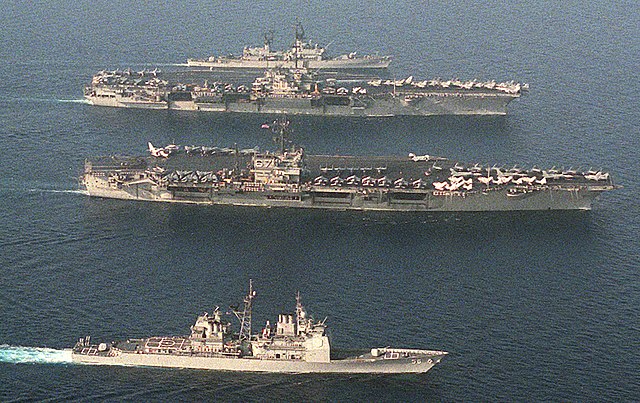
USS John F Kennedy (CV-67) and USS Saratoga (CV-60) underway.
All four ships never saw the end of the Korean War (mostly Essex clas vessels operated there) as built and completed, but they were ready for a tense period in the Mediterranean, and of course all four saw their fair share of action in Vietnam, where they were relatively recent, and were heavily committed.
On July 29, 1967 however, USS Forrestal’s frantic operating pace was shattered when a Zuni rocket accidentally fired from an F-4 Phantom into a parked and armed A-4 Skyhawk. This caused a cascade of catastrophies, after the belly fuel tank blasted, making a 1,000 pound bomb on the Skyhawk falling off, spilling jet fuel onto the flight deck which fed an anormous and soon uncontrollable fire.
The massive chain reaction of explosions of the whole air parked fully loaded for a strike between Fuel and bombs eventualy gushed the armored flight deck and ignited new fires on lower decks resulting in the largest loss of life of the USN since USS Franklin (CV-13). 134 died and 64 were injured in the event, which trigerred a wave of safety measures and more caution in operations.
Forrestal made 21 successful operational deployments during thorty years of service, seeing the end of the cold war, and 1991 Operation Provide Comfort relief effort for the Kurds of Iraq. Changing home port in February 1992 to Pensacolan FL, she became a training carrier and her 14-month overhaul was discontinued in March 1993 when scheduled for decommissioning in relation to the closure of the Pennsylvania Naval Shipyard.
USS Saratoga was attached to her home port of Mayport, FL, and was off Cuba during the Cuban missile crisis, but also Lebanon during the Six-Day War, in the Tonkin Gulf, the Red Sea during (Persian Gulf war) transiting the Suez Canal by night, a first at the time. Her 38 year career ended in January 1994, making her last missioned in the Adriatic to support operations `Deny Flight’ and `Provide Promise’ over Bosnia-Herzogovina, and full decommission in August.
USS Ranger, Commissioned in 1957, served in the Pacific and was the longest implicated in constant operations in the Vietnam War, earning 13 battle stars in the process of her four deployments. Later she also served in the Indian Ocean and Persian Gulf and was eventually decommissioned in July 1993, but only stricken in 2004, but stayed in long term reserve at Bremerton, Washington, until March 2015. She was scrapped in Brownsville in 2017.
USS Independence was attached to San Diego home port for most of her long career of 36 years. She had in June 1988 her SLEP overhault at Philadelphia and join Yokosuka as her new home port in 1991 as a permanently forward deployed aircraft carrier. On June 30, 1995, she became the oldest vessel in service and not even decommissioned by late 1998. Her last deployment was in July 1998, leaving Yokosuka, and decommissioned this time 30 September 1998. She nearly missed the second millenium.
Gallery

USS Forrestal starboard view 1955
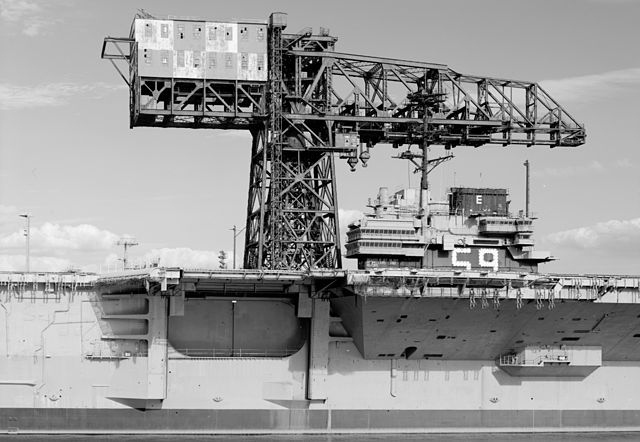
350 ton crane at Philadelphia NS with AVT-59 1995
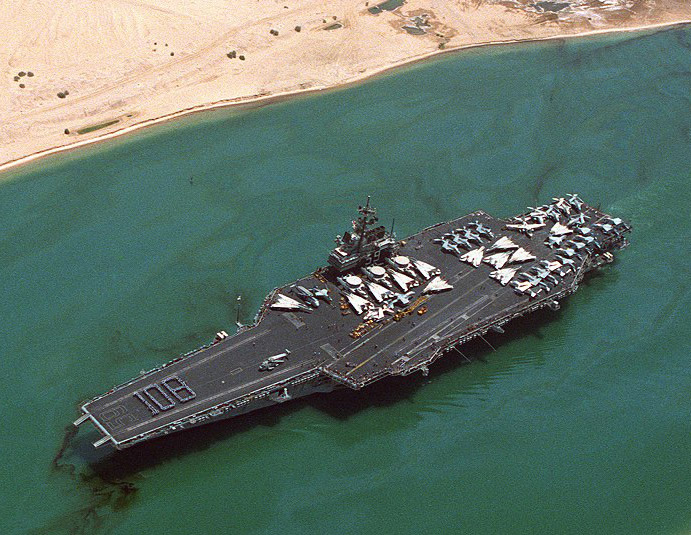
USS Forrestal Suez canal 108 days at sea
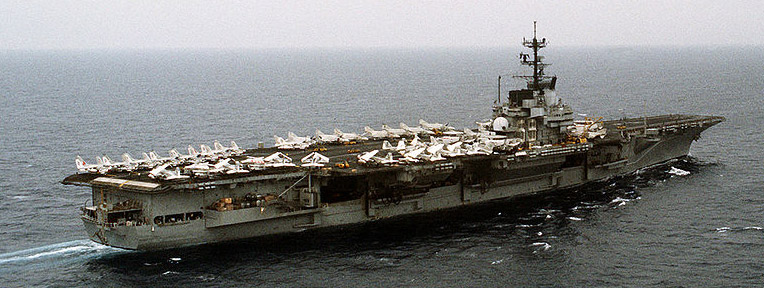
USS Forrestal aerial starboard quarter
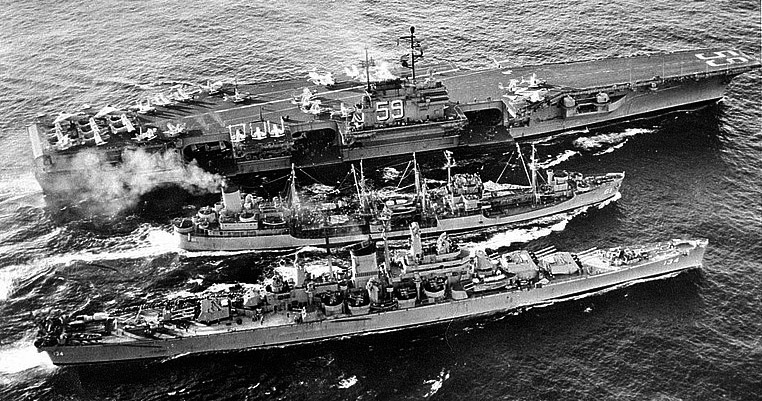
USS Severn (AO-61) refuels USS Forrestal and_USS Des Moines (CA-134) in the Atlantic Ocean, 11 November 1956

Cross-deck operations of US F-4J and RN F-4Ks on CV-62
Links/Src
Books
J.Gardiner, R. Conway’s All the World’s Fighting Ships, 1947–1995
Donald, David; Daniel J. March (2001). Carrier Aviation Air Power Directory. AIRtime Publishing
Cracknell, W.H, Warship Profile 15, USS Enterprise (CVAN 65) Nuclear Attack Carrier
Friedman, Norman (1983). U.S. Aircraft Carriers: An Illustrated Design History. Naval Institute Press
Links
Forrestal on virtualwall.org
wiki
CV 59 on Navsource
Paul H. Friedman’s USS FORRESTAL CVA-59 web site
On globalsecurity.org
The class on hazegray.org
Navypedia (archive)
About USN radars
On history.navy.mil
The catasrophy of USS Forrestal
On seaforces.org
Decomm. on navytimes.com
USS Forrestal memorial
On nationalcoldwarexhibition.org
Last voyage of USS Forrestal
First page of the 1967 Forrestal Cruise Book
uss-forrestal.com assoc
Model kits
 general query on scalemates and the very rare and gigantic Wilhelmshavener Modellbaubogen Mowe-Verlag WHM-1200 1:250 kit
general query on scalemates and the very rare and gigantic Wilhelmshavener Modellbaubogen Mowe-Verlag WHM-1200 1:250 kit
The Forrestal was quickly adopted by model makers in the 1950s, like Advant at 1:542, Heller/Revell at the same scale, Monogram, Estrella, Lodela which retook the revell kit. Airfix also tackled it at 1:600, as Aurora, and Monogram as well as Necomisa and Lodela. At last Italeri made a 1:720 kit, distribited and manufactured also by testor, and Nichimo was the first to propose a 1:750. ARII made a 1:800, as well as Micro Ace, as well as Nitto and Toho. At last Playkit proposed for tabletops fanatics it’s USS Saratoga at 1:2500. The model has been well covered by 3D recently. Gold Medal prposed the 1:720 photosheet decals for the Italeri model as well.
 USS Forrestal CV-59
USS Forrestal CV-59

Forrestal on trials 1955
USS Forrestal was commissioned on 1 October 1955 and joined her her home port, Naval Station Norfolk, in Virginia. Her first service year was of course essentially intensive training, soon receiving her air group and multiply operations off the Virginia Capes and Caribbean in the winter, but also cruising as north as Maine. Training aviators and evaluating her advanced facilities was particularly useful as these reports led to last-minutes changes for her sister ships still in construction.
In 1956 she started to operate more often from Naval Station Mayport, Florida. On 7 November she made her first foreign cruise, reaching the eastern Atlantic as the Suez Crisis developed. But she did not ented the Mediterranean staying in hig alert. The crisis eventually revolved itself and she was back to Norfolk on 12 December, to be redeployed with the 6th Fleet in the Mediterranean, departing on 15 January 1957. She toured the Mediterranean, stopping in many ports to show the flag and attracting a lot of interest wherever she was as the largest warship afloat. Many dignitaries and the general public boto visited her.
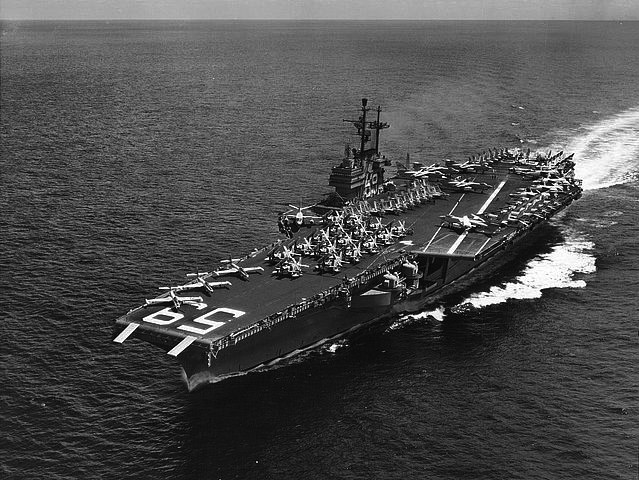
CVA-59 underway at sea 1957
On the political side this was also a huge PR success as the cold war was just getting hot in many areas, around notably in Greece and the Balkans. Demonstrations to project air power were made, to and from the sea and in coordination with the 6th fleet escorts. Back in Norfolk on 22 July 1957, she started a round of exercises off North Carolina for her first NATO operation: Operation Strikeback. This was a north sea deployment from 3 September to 22 October and coordination effort with NATO navies and in particular the Royal Navy facing the Soviet threat and testing scenarios.
In 1958, she took part in new major fleet exercises as well as some experimental flight operations and tests opf new models. The Lebanon Crisis of summer 1958 saw her sent in the eastern Atlantic, from Norfolk on 11 July with her new air group, patrolling the Atlantic and back on the 17th before a second tour of duty (TOD) in the Med, from 2 September 1958 to 12 March 1959 and a program close to what she did in 1957. She notably carried Secretary of Defense N. H. McElroy.
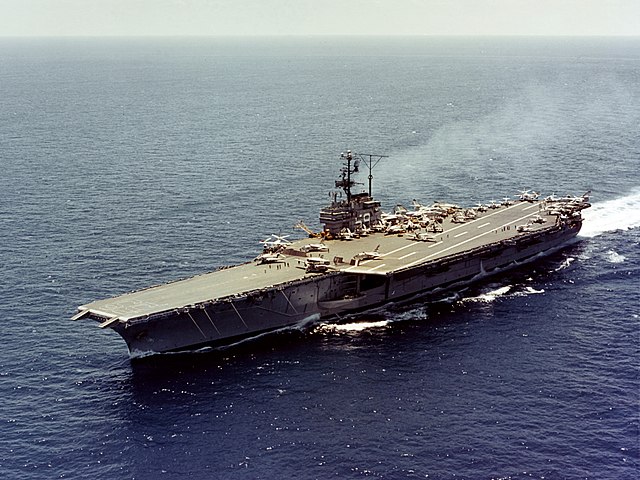
USS Forrestal underway 31 May 1962
Her third TOD with the 6th Fleet was in 28 January – 31 August 1960, also visiting many ports and staying longer than usual in Split, Croatia. Her 5th TOD was between January-August 1961 before a well deserved overhaul in Norfolk. Here, modifications were made to her arresting wires, replaced with four new ones and berthing areas freed while the right side flight deck mirror was replaced by Fresnel lens in the port catwalk. Past her shakedown cruise in Guantanamo Bay, January 1962, she stopped in Port-au-Prince and Port of Spain and took part in a defending fleet for a landing exercise on Vieques Island with the largest fleet assembled since the Korean War. She hosted Vice-President Lyndon B. Johnson and John F. Kennedy as well as many foreign ambassadors and staffs during another exercize off the Virginia Capes in June 1962.
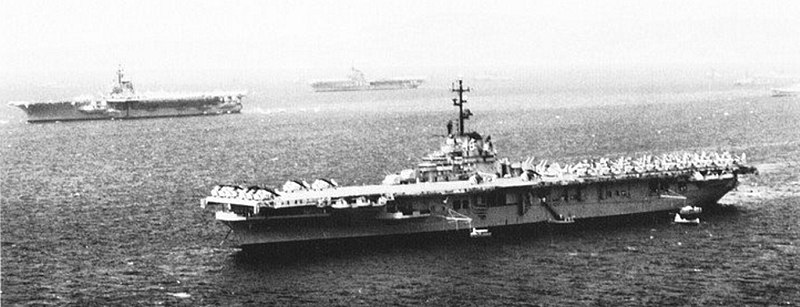
USS Valley Forge, USS FD Roosevelt and USS Forrestal sailing together in 1960
Her 6th TOD with the 6th fleet was between 3 August 1962 and 2 March 1963, this time as flagship, ComCarDiv 4. She took part in several NATO exercises between Atlantic and west Mediterranean, teamling with the newly commissioned nuclear carrier, USS Enterprise, and also British and French aicraft carriers, performing cross deck operations and interoperability exercises with HMS Ark Royal. When one USMC Phantom aboard HMS Ark Royal developmed prblems it was simply absorbed in to the British own fleet of F4s.

CV-59 under the Verrazano-Narrows Bridge
In November 1963, some 21 full-stop landings and takeoffs were made experimentally with a C-130 Hercules, demonstrating it was possible. This was done some 500 nautical miles (930 km) off Massachusetts coast. She setup records which still holds today. The idea was to use the Hercules as a “Super-COD”, or “Carrier Onboard Delivery” aircraft for mid-ocean replenishment. In 1964, she took part in Operation Brother Sam, supporting a military coup against Brazilian president João Goulart. On March 15, 1966 she was with the 6th at Palomares, Spain to assist a nuclear disaster cleanup and H-bomb recovery after aa B52 crashed.
Forrestal’s tragedy: The great fire of 1967
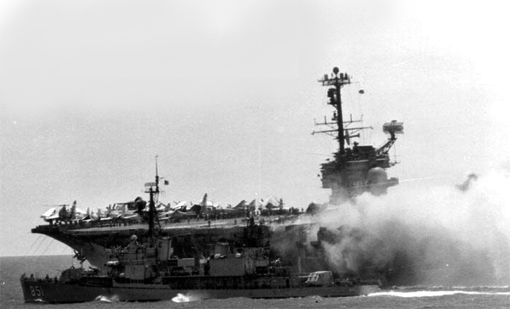
USS Forrestal in trouble in the Viet-Nam suffering a fierce fire, one of the worst catastrophies in cold war US naval history
In June 1967, she departed for her first TOF in Vietnam. She was in the Gulf of Tonkin on 29 July, launching aircraft and during four full days, Air Wing 17 flew flew about 150 missions over North Vietnam. On 29 July while another strike was in preparation with the deck full of waiting aircraft being serviced close to launch, full of avgas and weapons loaded, a Zuni rocket from F-4 Phantom (#110) self-ignited (probably due a short) launched itself to impact an armed A-4 Skyhawk #405 on the port side, which dislodged and ruptured her 400-gallon external fuel tank, starting to leak and roll happily over the deck, spraying high octane gasoline over the scorched heated deck.
Soon catching fire, it started a chain reaction that impacted all planes on deck, the heat successively detonating the ordnance and other gasoline tanks. The result was pandemonium on a never seen scale at least since WW2 and unsurpassed in the cold war. For hours, the raging inferno killed 134 and injured 161 while destroying nearly all of the 21 aircraft on deck. Total cost was estimated U$72 million worth of assets. Lieutenant Commander (later Senator) John McCain was the CO that day. The enquiry blamed maintenance head but did not single-out the real reasons of the short at first. Since the, safety made quite a leap forward on, board US Carriers; Apart on USS Enterprise in 1969, again due to a Zuni rocket detonating off Hawaii, this ordnance started to be retired. It whould be said however that at this stage of the war, the bombing campaign was so intense that vintage WW2 bombs were routinely used, showing alarming chemical instability and sometimes general poor condition.
Forrestal’s 1970s Service
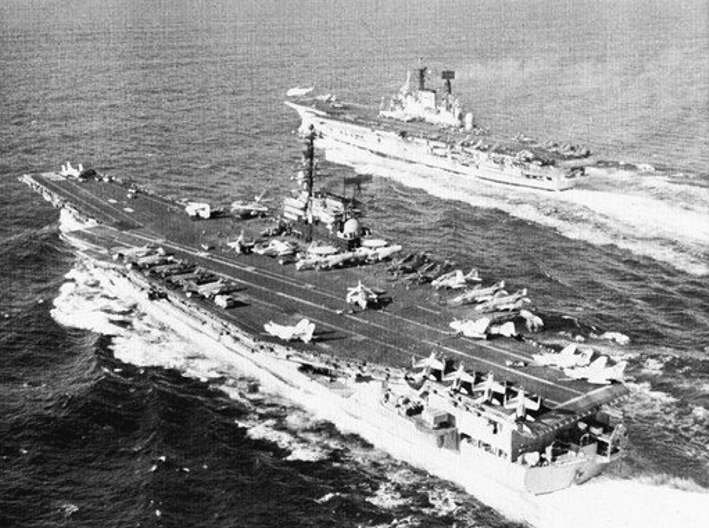
Forrestal and Ark Royal underway in 1973
After repairs in Norfolk, USS Forrestal was Back in the Mediterranean waters for four more TODs in 1968-1973. And then again three more in 1973, 1974 and 1975. On 22 July 1974 the Turkish invasion of Cyprus prompting an evacuation of U.S. citizens there, in a joint Navy-Marine Corps effort, with notably USS Inchon. In all 466 people were evacuated, US and internationals, with air cover provided. In October 1968 CV-58 she lost an E-2A Hawkeye during a routine night operation recovery, which dove into the water, nose first, loosing three of the crew of five.
On 10 July 1972 while at Pier 12, Norfolk for Maintenance, a fierce fire broke out, set by a disgruntled (later condemned) crewmember at O-3 level computer room under the flight deck. The hole necessitated to pour hundreds of water gallons to douse it and ruin the computer equipment. The firefighting team was so thorough the ship took a severe list. She was repaired at Portsmouth, relieved by USS John F. Kennedy in the Mediterranean and most of the CIC and electronics reserved for USS Nimitz under construction were used to repair her CiC room.
In June 1974, 34 sailors and two officers were present at the 30th anniversary of D-Day in Normandy, France, later passed in review by retired General Omar Bradley. On 30 June 1975, the carrier was redesignated a “Multi-purpose Aircraft Carrier” or CV-59, selected as host ship for the NYC International Naval Review and Bicentennial held on 4 July 1976, with President Gerald Ford aboard, admiring 40 tall ships. Next, she took part in a special shock test, detonating high explosives near her hull to appreciate what a near-miss could do with modern ordnance. It was successful as damaged was limited.
This coincided with a 7-month overall ending on September 1977 in Norfolk and she headed for her shakedown to Mayport and from 13 January 1978 made a 3-week Atlantic Fleet Weapons Training Facility (AFWTF) deployment at the Roosevelt Roads Operating Area for TYT-3 and Operational Readiness Evaluation (ORE). However on 15 January 1978 an A-7 Corsair II (VA-81) missed its landing and crashed on the deck, killing 2, wounding 10. The enquiry determined iot was a faulty radio and misinterpretation of approach signal, but he ejected safely. The A-7 percuted and carried for a dozen meters an EA-6B in flames on the aft deck, but fire was quickly extinguished. The specter of 1967 had led indeed to torough training and measures. This happened off St. Augustine, Florida.
Forrestal left Mayport for the Mediterranean again on 4 April 1978 but at 22:00 on 8 April, N°3 Main Machinery Room saw fire reupting just after a drill due to freshly painted thermal insulation inflamed by hot steam lines but quickly doused by the extinguishing system. At midnight on 11 April a fire started on the catapult steam trunk at 01 level and in the adjoining storeroom, this time which need about an hour to be dealt with by the fire brigade. On 10 May 1978 in Guantanamo Bay flooding started due to a faulty pump aft, up to 20 feet (6.1 m) before controlled, spreading into the food storage rooms. The ship’s own Explosive Ordnance Disposal (EOD) diver’s team managed to enter the pump room and plug the leak.
19-29 May 1978 was NATO Operation Dawn Patrol with air and ground forces, plus 80 ships from six NATO countries and seeing CV-59 covering the Turkish amphibious task group with USS Nimitz and the French carrier Foch. This also saw two air crashes. An A-7E on 24 June 1978, and on 25 June another from VA-83 this time due to a catapult malfunction. It happened in the Ionian Sea, east of Sicily. On 4-19 September, she took part in Northern Wedding, with 40,000 men, 22 submarines, and 800 aircraft from nine NATO countries, teaming with HMS Ark Royal and supporting mock landings in the Shetlands and Jutland. On 28 September-10 October tis was Display Determination final exercise with assets from eight NATO countries in the southern European region, and she operated from Rota, Spain.
On 13 October she trained with USS Saratoga, her air group conducting mock attacks and she was back in Rota. On 15 October she departed Rota to join the Sixth Fleet, relieved by Saratoga. She took part in Windbreakwith 2nd in command Vice Adm. Wesley L. McDonald aboard, to test new waters and gauge Soviet interest towards them. Forrestal reached 62° lat. 150 miles (240 km) south of Iceland in very choppy seas with waves 34 feet (10 m) high and 70 knots (130 km/h) winds in sub-zero temperatures escorted by the missile cruiser USS Harry E. Yarnell and destroyer USS Arthur W. Radford.
Back in Mayport on 26 October she underwent a 4-month upkeep and her Extended Selected Restricted Availability (ESRA), until 27 August 1979, making an emergency sortie due to Hurricane David in her path at the time. She weathered the at sea, emerging in its eye and coming opposite without much damage, only manned with a skeleton crew. She made her 15th Mediterranean cruise (November 1979-May 1980, celebtrating her silver anniversary in October, then making her 16th Mediterranean deployment in March 1981.
Later career: 1980s to 1990s
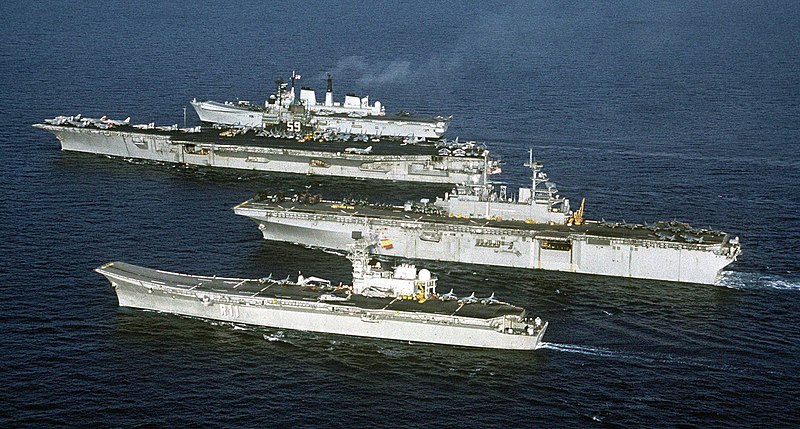
Principe de Asturias, Wasp, Forrestal and Invincible in a 1991 NATO Mediterranean exercise
On 2 March 1981, she started her 17th Mediterranean deployment, being present for the Syria/Israel missile crisis, staying in high alert on site for 53 days. Whene she was in the Gulf of Sidra for an exercise, two Libyan aircraft were shot down after firing on F-14s from USS Nimitz, over international waters. Forrestal’s own air group performed most of the interception of Libyan planes. Next she took part in Ocean Venture ’81 held in the Arctic Circle after a refit, made her 18th Med TOD started on 8 June 1982, staying in the eastern Mediterranean as the Lebanon crisis started, covering the landing of 800 U.S. Marines in Beirut. On 12 September 1982, she crossed the Suez Canal for the first time, for the Indian Ocean for operations wth the 7th Fleet, long after being deployed in her short and tragic 1967 Vietnam TOD.
She made a 4.5 months deployment there before arriving in Mayport on 16 November 1982 and entered drydock for her major life overhaul, the Service Life Extension Program (SLEP). She was based in Philadelphia Naval Shipyard in Philadelphia, being overhauled from January 1983, lasting for 28-month, for a career extension estimated to be 15-20 years. When over, she departed on 2 June 1986 for her 19th deployment in the Med, operated in the Tripoli Flight region and taking part in Operation Sea Wind with Egypt, and later Display Determination, with Turkey. In 1987 she made some refresher training and carrier qualification before heading for the North Atlantic for Ocean Safari ’87 in Norway.

USS Belknap (CG-26) and USS Forrestal underway in the Mediterranean Sea, 20 August 1988
Back home she went up the Mississippi River and stayed in New Orleans, hosting some 40,000 visitors. She made her 20th major deployment on 25 April 1988, in the North Arabian Sea via Suez for Earnest Will staying 108 consecutive days at sea. She was back home on 7 October 1988 earning the Meritorious Unit Commendation for her last operation. She took part in NYC’s “Fleet Week” in May 1989 and in 1989 was awarded thee Marjorie Sterrett Battleship Fund Award for her Atlantic Fleet career. Her 21st major deployment was delayed by a fire in her primary command and control trunk space, injuring 11 sailors and costing millions. She departed on 6 November 1989. Later she assisted President George H. W. Bush during his Malta Summit and was visited by him for long hours. Exercizes there included “Harmonie Sud” (wuth Tunisian forces), and the country’s National Week. Back to Mayport on 12 April 1990, she was drydocked until 27 August 1990 for maintenance at Norfolk, having her catapult system upgraded and other changes for the new F/A-18 Hornet.
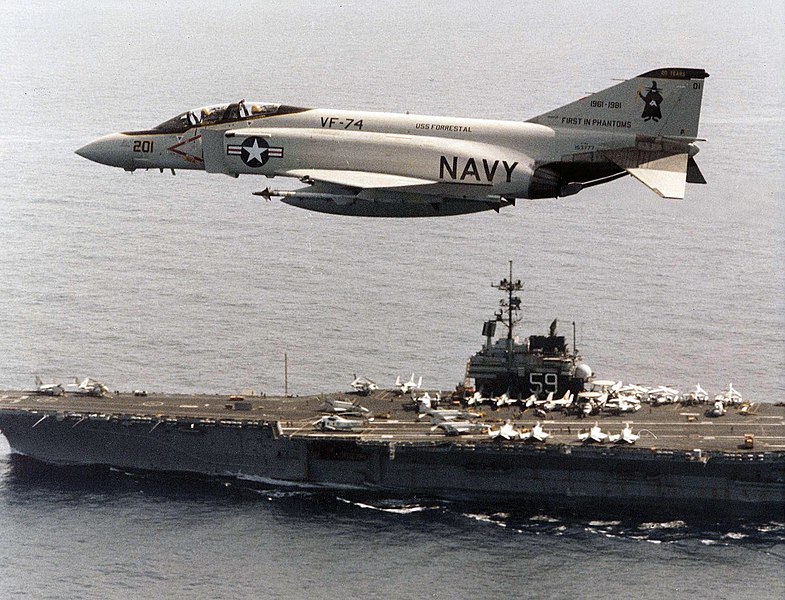
F-4J Phantom II of VF-74 in flight over USS Forrestal 1981
In 1989 she also took part in a 11-day carrier task force training with SEAL Team Six, South West Caribbean sea, off the Panama and Colombian coasts, for Operation Pokeweed, to apprehend Pablo Escobar. In 1991 she stayed 5 months in full combat readines on the east coast, so her crew was finely trained for Operation Desert Storm but she was not deployed. Her final deployment started on 30 May 1991 in a “transitional” readiness status. For six months she provided air cover and airborne intelligence for Operation Provide Comfort, taking part in new and innovative Sixth Fleet battle group tactics.
She headed afterwards to NAS Pensacola FL, to take her role as training carrier, in place of USS Lexington, redesignated AVT-59. She started her new role on 4 February and visited again New Orleans in May 1992. On 14 September 1992 in Philadelphia NyD she started her last, 14-month and $157 million refit as training carrier but it was cut short in early 1994 as decision was taken to have her decommissionned. This left the Navy without dedicated tranining carrier.

USS Forrestal and USS Saratoga right berthed at the Naval Station Newport RI
Decommissioned on 11 September 1993, she was stricken the same day, but kept in long term reserve. On 16 June 1999, the Navy announced she could be allocated to a museum or memorial. However the campaign started by USS Forrestal Museum Inc. never reached the desired funds to proceed to the next step. She removed from donation hold in December 2003, returned to disposal ad after discussions to make her an artificial reef, in 2012 she was scheduled for complete dismantlement as her sister ships, and she was sold to All Star Metals in Brownsville, Texas and BU in 2014-2015. During her 37 years career her numerous mishaps earned her the nicknames of “Forest Fire”, “Firestal” and even “Zippo”.
 USS Saratoga CV-60
USS Saratoga CV-60
USS Saratoga (CV-60) underway in the Adriatic Sea on 29 July 1992
USS Saratoga was commissioned on 14 April 1956, with CAPT Robert Joseph Stroh in command. For several months, her crew was trained hard: Engineering, flight, steering but also gunnery trials. On 18 August 1956, she made her first shakedown cruise, to Guantanamo Bay. On 19 December, she was back for post-trials fixes in New York Naval Shipyard, until 28 February 1957. She made later a refresher training cruise again in the Caribbean and when judged ready, sailed to take her definitive home port, Naval Station Mayport (FL).
On 6 June 1957, president Dwight D. Eisenhower and his cabinet visited her. They observed operations for two days with eighteen other ships performing antisubmarine warfare and guided missile operations, while the carrier demonstrated very latest bombing and strafing techniques. There was also a non-stop flight overhead of two F8U Crusaders than brand new, taking off from USS BonHomme Richard off the West Coast and flying over USS Saratoga in the Atlantic, making the US continental crossing.
USS Saratoga also took part that year to Regulus guided missile tests, setup and modified to operate this new turbojet powered subsonic guided missile. In fact only six carriers uin the Navy ever launched this nuclear-tipped strategic missile, a first contribtion of the Navy to the US deterrence. She also left Mayport on 3 September 1957 for her first transatlantic voyage, reaching the Norwegian Sea for Operation Strikeback, a joint maneuvers with northern NATO countries. After a stop at Mayport she end the year in refit at Norfolk.
Saratoga’s Mediterranean service

USS Saratoga off Barcelona on 12 February 1965 for a naval review
On 1 February 1958, she made her first TOD in the Mediterranean, with the Sixth Fleet like her sister ship Forrestal. This was the first of yearly deployments there until 1967, eight cruises in all. On the night of 24–25 May 1960, she collided with the German freighter Bernd Leonhardt, off North Carolina. Her flight-deck needed to be repaired, but there was no casualty on the carrier. Repairs were to about 2.5 million German marks, paid to the U.S. Navy.
On 23 January 1961, her number two machinery space erupoted in flames, making seven dead. It was believed to have originated in a ruptured fuel oil line. In Athens a damage survey was made and she went on with her mission until back home for repair. It’s only by mid-1964, that Saratoga returned to the Mediterranean, and for 6 months in 1965 visited Naples, Athens, Cannes, Valencia, Istanbul and Malta. The 1966 Med cruise was followed by the 1967, June to December, of routine service without anything notable but a serie of NATO exercises.
In the eastern Mediterranean she witnessed the 1967 Arab-Israeli war. Her medical facility treated survivors of the Israeli attack on USS Liberty. She nearly collided with the missile cruiser USS Little Rock, cutting across her bow during flight operations. It was Saratoga’s turning to port after signalling the contrary that put Little Rock in grave danger leading to an investigation. In December 1967 she was caught in a fierce Atlantic storm damaging external catwalks and flight deck as well as boat sponsons.
On 2 January 1968, she was ovehauled at Philadelphia Naval Shipyard, for 11 months. On 31 January 1969, she headed for Guantanamo via Hampton Roads and her refresher training before being mobilized on 17 May 1969, to be the host ship for President Richard Nixon, during a demonstration by Carrier Air Wing Three in the Virginia Capes. On 9 July she made her ninth Med TOD while underway followed closely by a November-class submarine en route to Cuba. While off the Azores on 17 July she was shadowed by Soviet aircraft, intercepted, photographed, and escorted out.
With Task Group 60.2, Sixth Fleet she took part in a show of force in the eastern Mediterranean as a Soviet fleet was gathering here, after the hijacking of a TWA plane to Syria plus the coup in Libya. Carrier Wing Three’s aircraft were quite busy in a tense situation, agresive manoeuvers from Soviet surface units led by the helicopter carrier Moskva, SE of Crete. Saratgoa was off Lebanon as a crisis developed and on 28 September 1970 was visited again by President Nixon and team.
There was a state of high alert as Gamal Abdel Nasser, President of the United Arab Republic was rumored to had died, with consequences to the Middle East. Intelligence gathering was intense and the president the ship the next evening while she patrolled until the crisis was over. She departed for home on 2 November, arriving in Mayport, and until 10 March 1971, semi-decommissioned. After a sortie off Florida until 7 June she departed for her 7th Med TOD via Scotland to take part in NATO “Magic Sword II” with the RN. Back to Mayport on 31 October she was again placed in restricted availability
USS Saratoga in Vietnam
USS JF Kennedy and USS Saratoga underway
On 11 April 1972, she departed Mayport for Subic Bay, Philippines, the main advanced USN base for the late deployment in Vietnam. She entered for the first time to the Western Pacific. On 9 May she departed for Vietnam and took her position at “Yankee Station” on the 18th, the frontline. Until the end of the year she was in the Tonkin Gulf seven times, reclassified in between as a “Multi-purpose Aircraft Carrier” (CV-60), on 30 June 1972. Her air group flew thousands of sorties, and she lost four aircraft and three pilots.
On 21 June, two F-4 Phantoms attacked three MiG-21s over North Vietnam and managed to shot down one. Her air group targeted enemy troop concentrations notably in the petroleum storage areas northeast of Hanoi. She lost an F-4 to enemy fire NE Hanoi and flew 708 sorties. On 6 August, LT Jim Lloyd (VA-105) lost his A-7 Corsair to a SAM near Vinh, ejecting into enemy territory adn recuperated after a daring rescue by helicopters, lifted in the midst of enemy soldiers back to Saratoga. On 10 August one of her CAP jet fighters shot down an intercepted lone MiG at night with its AIM-7 Sparrow missiles.
On 2-19 September 1972 her aor group made 800 strike missions over North Vietnam and on 20 October alone, 83 close air support sorties were made for six hours to support 250 SVA Territorials surrounded by the NVA 48th Regimentand action which saved the small force and even allowed the ARVN to advance. Her last week in Vietnam, her air group was hammering many targets in North Vietnam and she lef “Yankee Station” for Subic Bay on 7 January 1973. Via Singapore and Suez, she sailed back to Mayport, arriving on 13 February 1973.
Later years 1980s
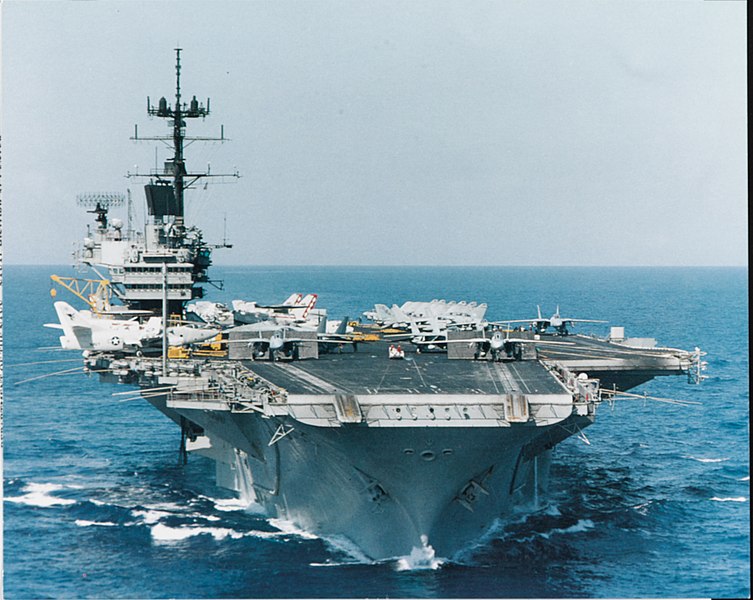
USS_Saratoga_underway_1985
She was affected to the North Atlantic Fleet and in 1975 took part in NATO Locked Gate-75, to contain the influence of the Portuguese Communist Party in Portugal after the Carnation Revolution, even entering the Tagus River delta and closing to the Presidential Palace of Belém. By January 1976 she made another Med TOD, with VS-22, newly constituted to flew the S-3A Viking ASW aircraft for it’s first deployment. She was also present during the Lebanon crisis in 1976.
On 3 October 1978, she made a new Med TOD, until 5 April 1979. On 21 November she collided with the replenishment oiler Waccamaw while 50 miles (80 km) south of Crete during a refuelling operation that turned badly. She only suffered minor damage. after conveying CVW-3 in her 16th Med TOD. She teamed with USS Forrestal battle group and hosted CNO ADM Thomas B. Hayward. On 28 September 1980, a month after returning to Mayport, she was in Philadelphia for her 28-month SLEP overhaul, at the time the most extensive industrial overhaul ever performed on any Navy ship.
USS Saratoga in fact was the very first of the class to test the Service Life Extension Program overhaul. She was back for sea trials on 16 October 1982, applauded by a huge crowd of “Philly” residents as “Super Sara.” She later departed Mayport for her 17th Med TOD on 2 April 1984 and later in 1985 her 18th deployment. But the latter was quite special: On 10 October the Italian luxury liner Achille Lauro, was hijacked by terrorists from the Palestinian PLF. Negociations partly failed and the hijackers went ashore at Port Said while Egyptian authorities tried to convinced the terrorists to depart, boarding an Egypt Air 737 at Al Maza Air Base, NW Cairo.
President Ronald Reagan ordered Saratoga’s seven F-14 Tomcats from VF-74 “Bedevilers” and VF-103 “Sluggers” to scrambled, supported by VA-85 Grumman KA-6D air tankers and E-2C Hawkeye (VAW-125), which encountered the Egyptian jet off Crete. They surrounded the civilian jetliner, turned on their lights and dipped their wings to urge them to do a forced landing. The hijackers were convinced to follow the Tomcats to Naval Air Station Sigonella, Italy. There, the hijackers were arrested and all Saratog air group was back. Mission accomplished without a shot fired, now an example of perfectly successful forced landing mission.
On 23 March 1986, while off Libya, the combined air groups of USS Saratoga, Coral Sea and America willfully crossed Muammar al-Gaddafi’s “Line of Death” while ships later in turn crossed the contested navigational line. Libyan forces fired SA-5 Gammon SAMs from Surt, missing the F-14 Tomcats. Later two Libyan MiG-25s were intercepted and forced to turn back over the Gulf of Sidra. Next, the Libyan Navy attacked and an A-6E Intruder fired Rockeye cluster bombs and a Harpoon cruise missile at a Libyan missile patrol boat on the “Line of Death”, resulting in its destruction. The night saw two A-7E Corsair II destroying a radar installation at Surt and two more Libyan patrol boats destroyed.
On 22 September 1987, an F-14 Tomcat (VF-74) of NAS Oceana, Virginia Beach (VA) operating from Saratoga shot down by accident while training a USAAF RF-4C Phantom II from the 26th Tactical Reconnaissance Wing. It was coming out of Zweibrücken Air Base in West Germany for NATO “Display Determination 87”. Pilots ejected and were rescued bu Saratoga’s helicopter while the pilot was disciplined and removed from service. Saratoga made her 19th Med TOD from June 1987 before another overhaul at Norfolk for $280 million.
Operation Desert Storm and retirement
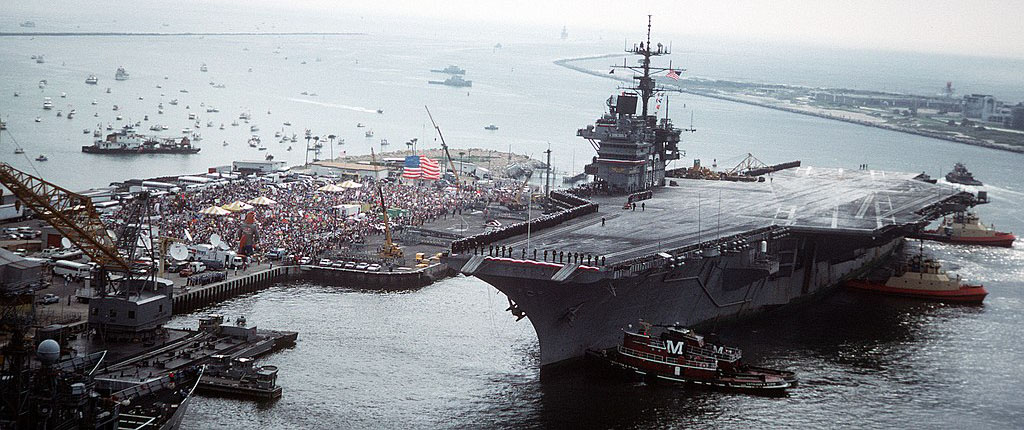
USS Saratoga back from Desert Storm
CVA-60 with her airwing CVW-17, took part in Operation Desert Storm from the Red Sea. It happened while she lost 21 crewmembers in a ferry boat accident off Haifa. The gulf was would gave her thje occasion of setting up two records: Six transits of the Suez Canal and 11,000 aircraft launch and recovery cycles. Saddam Hussein boasted on Iraqi television he sunk “lady sara” and other Coalition vessels which was of course fake news, but launching SCUDS nevertheless. One of these indeed flew in the “general direction” of the carrier and while tracked by radar, missed 100 nautical miles… She would have one A-6E Intruder short down over Iraq and Bombardier/Navigator LT Jeffrey Zaun later paraded before cameras by its captors but later freed and able to return to Saratoga. The carrier also covered SEALs making the first wartime boardings of merchant shipping in the Red Sea later for Operation Desert Shield.
Back in her Mediterranean routine she was in the midst of a serious incident with a NATO member in the fall of 1992. It happened in “Exercise Display Determination 1992”, under command of ADM Jeremy Michael Boorda, USN. The two multinational teams mimicked opposite forced and VADM T. Joseph Lopez led the “Brown Forces” (with Saratog and Cruiser-Destroyer Group 8) leading a defence against the opposing “Green Forces”, with the Turkish destroyer minelayer TCG Muavenet under command of Admiral Kroon, NL Navy.
The “enhanced tactical” phase saw the Brown Forces attempting an amphibious landing at Saros Bay defended by Green Forces. ADM Boorda ordered units to seek and destroy each other. These simulated attacks went AWHOL when on 30 September 1992, Saratoga’s combat direction center tactical action officer (TAO) decided to launch a simulated attack using the RIM-7 Sea Sparrow,securing the approval of the CO and battle group commander, RADM Philip Dur. However certain members of the missile firing team were not told this was a drill and believed it an actual event and ended firing a live missile, due to further miscommunication.
Two live Sea Sparrow missiles targeted at TGC Muavenet were effectively lanched, and struck the destroyer in the bridge, destroying it and it’s CIC as well as killing the commanding officer, four others, while injuring most of the remaining officers. On recommdendation later after enquiry, Saratoga’s captain and seven other officers were disciplined and Turkey received the flattest state apologies.
Eventually, USS Saratoga was decommissioned at NAS Mayport on 20 August 1994, stricken and later towed to Philadelphia in May 1995 for full deactivation at Philadelphia Navy Yard, which proceeded from August 1998. She was next towed for preservation at NAS Newport in Rhode Island and placed on donation hold, but sold as “disposal as an experimental ship” and back to donation hold in 2000. Some efforts were made to convert her as a museum ship in Quonset Point, North Kingstown but this went to nil and in April 2010 she was removed from donation hold.
Efforts were also made earlier for the same purpose in 1994–95, but in Jacksonville, Florida but the fundraising campaign failed and on 8 May 2014, Naval Sea Systems Command announced that ESCO Marine in Brownsville, Texas was to receive the ship for demolition, for a symbolic one cent. She made her last towed trip on 21 August 2014, and arrived on 16 September. The scrapping was over 31 March 2019, before as the COVID pandemic stroke the US. Her anchors were recycled into the new carrier Harry S. Truman (Ford class). Her badge comprised a rooster and the latin inscription “Invictus Gallus Gladiator”.
 USS Ranger CV-61
USS Ranger CV-61
_at_Norfolk_in_1957_seatrials.jpg)
USS Ranger sea trials, with USS Leyte (CVS) nearby at Norfolk.
USS Ranger, second carrier of the name, was commissioned at Norfolk Naval Shipyard, on 10 August 1957, with Captain Charles T. Booth II in command. She departed for sea trials afterwards and joined the U.S. Atlantic Fleet on 3 October, before making her shakedown cruiser for Guantánamo Bay in Cuba while receiving aboard Attack Squadron 85 for air operations qualification and exercises, followed by final Navy acceptance trials between the eastern seaboard and Caribbean Sea. This was concluded on 20 June 1958. Departed Norfolk with 200 Naval Reserve officer she sailed for a two-month cruise down south around Cape Horn and back to her future homeport for years NAS Alameda, (CA) on 20 August, Pacific Fleet unlike her two sisters assigned to the Atlantic fleet. Her sister ship Independence also was sscheduled for the Pacific.
WestPac deployments
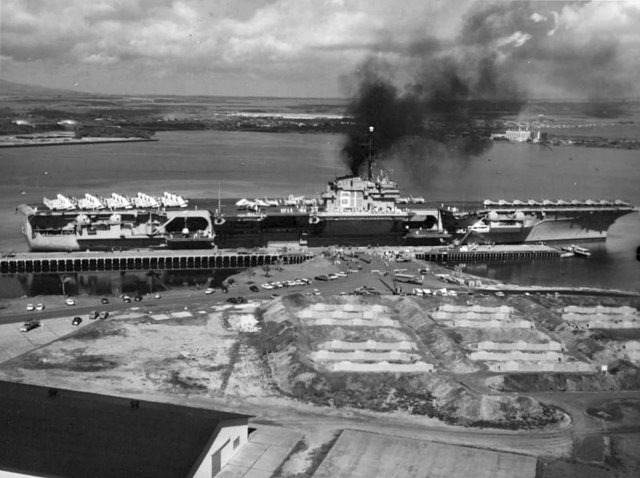
USS Ranger in Pearl Harbor 1959
This year saw further pilot qualification training (Air Group 14), fleet exercises and making her final training cruise from 3 January 1959 until 17 February to Hawaii and back, and as flagship, Rear Admiral Henry H. Caldwell of Carrier Division Two (CarDiv 2) and the 7th Fleet. Off Okinawa at first she operated with SEATO naval off Subic Bay in the Philippines, including a special weapons warfare exercise and patrolling south of Japan (WestPac TOD) making a record 7,000 sorties and back to San Francisco Bay on 27 July followed by a 6 months low readiness state.
She received Carrier Air Group 9 and departed Alameda on 6 February 1960 for her 2nd WestPac TOD and back on 30 August. Until 8 March 1962, the made a third deployment. Intensive training off the western seaboard was followed by another deplyment in Southeast Asia, departing from 9 November to Hawaii, and via Okinawa to the Philippines, Subic Bay. Her first deployment was in the South China Sea on 1 May 1963 as Laos needed help. The local crisis eased up on 4 May, and she resumed normal operations with the 7th Fleet. She was back at her home port on 14 June 1963 for an overhaul at San Francisco NyD from 7 August 1963 to 10 February 1964. After her refresher training on 25 March she cruiseed to Hawaii until 10 July.
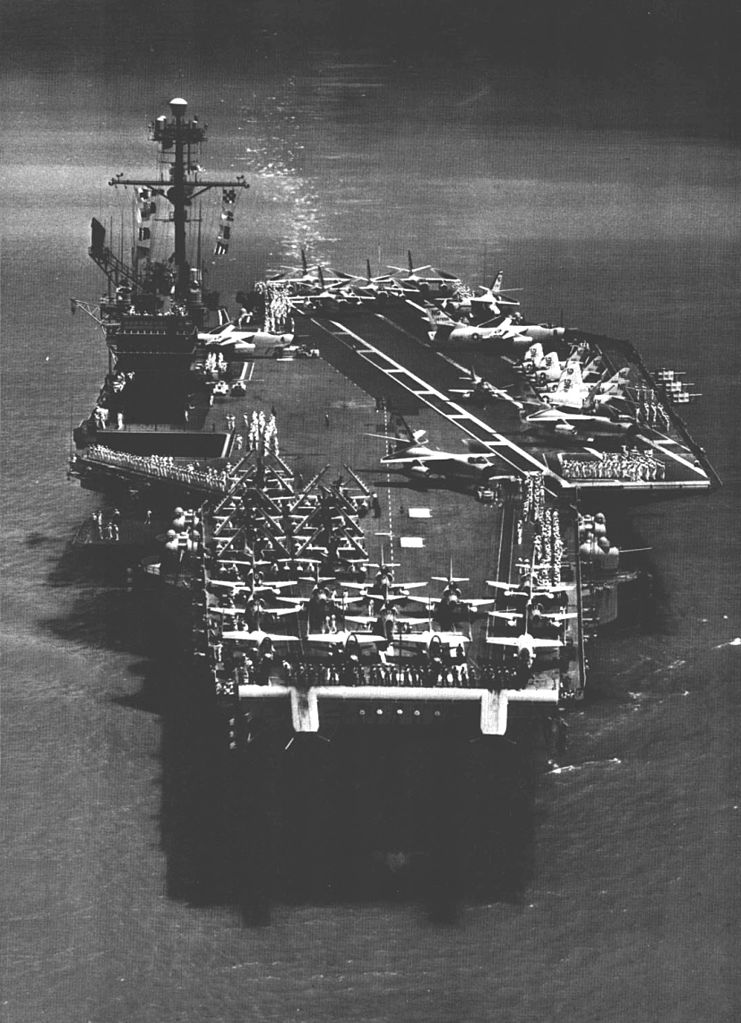
In May 1964 however she was sent briefly near French Polynesia to monitor French nuclear tests on Moruroa, launching and recovering a Lockheed U-2 from its flight deck. Tests and modifications were performed already by late 1963, recording just one landing accident (pilot Bob Schumacher). Next she resumed her next WastPac cruise on 6 August.
Vietnam War

USS Ranger off Hawaii 1967
This time, the Gulf of Tonkin incident prompter special preparations and she was rushed for it to Pearl Harbor on 10 August and back to Subic Bay and Yokosuka. On 17 October 1964, she was flagship, Rear Admiral Miller FCTF (Fast Carrier Task Force) 77, 7th Fleet, monitoring sea lanes, stopping Communist seaborne infiltrations.
General William Westmoreland visited Ranger on 9 March 1965 to discuss collaboration army-navy with Rear Admiral Miller. The carrier started a serie of coordinated air strikes until 13 April. This day she had her first serious accident as a fuel line broke, which ignited and engulfed her first main machinery. The fire was extinguished in an hour but there was a single fatality. Back on Subic Bay on 15 April she went back home to Alameda in May and San Francisco Naval Shipyard for repairs and overhaul until 30 September 1965.
After her refresher training cruise she departed on 10 December 1965 for the 7th Fleet with Carrier Air Wing 14 (awarded a Navy Unit Commendation for operations 10 January-6 August 1966). She was in Gulf of Tonkin until 6 August and headed for Subic Bay and later via Yokosuka for Alameda on the 25th, followed by an overhaul at Puget Sound until 30 May 1967, followed by training on the west coast. On 21 July 1967 was celebrated her 88,000th carrier landing.
Until November she made intensive training to reach perfect combat readiness status before high-level operations in the far east, and received Attack Carrier Air Wing 2 (CVW-2) on 15 September 1967, for the first time receiving the new A-7 Corsair II and UH-2C Seasprite rescue helicopter, the first carrier to have them operational. After a refresher training she took part in “Moon Festival” exercize (9-16 October). She departed Alameda on 4 November 1967 for Yokosuka and relieved USS Constellation. She was in Philippines on the 24th, followed by final preparations and combat operations in the Gulf of Tonkin at Yankee station, carrying CarDiv3 CinC on 30 November for TG 77.7.
She started war operations on 3 December 1967 over North Vietnam, for five very intensive months. Her air groups targeted a large variety of targets, included dangerous ones such as AA guns and SAM sites. Air Wing 2 was celebrated by Bob Hope’s Christmas Show live on 21 December. Her crew rested at Yokosuka in April and she was back to Yankee Station the same month. In January 1968 however the CIA manned intel ship Pueblo was seized by North Korea and Ranger rushed north at full speed for Operation Formation Star which concluded a continuous deployment of 65 days. Her crew rested at Sasebo for several days before she returned to Yankee Station. She sailed to Hong Kong on 5 May 1968 before departing for home.
She entered Puget Sound and in late July was in San Francisco. The crew had three months of well deserved leave before she made yet another WestPac from 26 October 1968, until 17 May 1969. In October she became flagship, RadM J.C. Donaldson, CiC CarDiv 3 under command of Captain J.P. Moorer. She stayed there until 18 May 1970 with two intense service tours at Yankee Statio, the second one of “only” 45 days as she experienced mechanical problems. She hosted again Bob Hope show on 24 December 1969. She left Yankee for Sasebo and to patrol the coast of Korea after NK aviaiton forced down a US C-130 and captured the crew.
Ranger was held on station to fly missioned over Cambodia and left Yankee Station for Subic Bay and Sasebo before proceeding back to Alameda (1 June). The summer was spent training on the west coast followed by her sixth WestPac cruise (October 1970). On 10 March 1971 she operated with USS Kitty Hawk in support to the troops, setting an absolute record of 233 daily strike sorties over North Vietnam. Task Force 77 at the time comprised USS Ranger, Kitty Hawk and Hancock at Yankee Station. Organization had one carrier always operational on daylight hours the other doing a night shift. The mission was the interdiction of major Laotian corridors to South Vietnam. She was back to her home port on 7 June 1971 and until early 1972 was in overhaul.
On 27 May 1972 she was back for her 7th WastPac TOD, delayed as she lost engines after fireman E-3 Patrick Chenoweth was accused of dropping a heavy paint scraper into a main reduction gear. This was not isolated, but one of many petty acts of sabotage she suffered from 7 June to October 1972. Through the court-martial was more lenient than the 30 years reclusion asked for at first.
On 18 December 1972 Linebacker II started as Paris peace negociations nearly stopped. USS Ranger was assisted by USS Enterprise, Saratoga, Oriskany, and America, for months of saily bombing missions over North Vietnam, Navy aircraft being task of detailed strikes against SAM and AA sites. They also targeted military installation and petroleum storage areas as well as targeting Haiphong, disrupting railroad and truck stations. These tactical sorties focused on the coast between Hanoi and Haiphong until 29 December when negociation resumed. On 27 January 1973 a cease-fire stopped all sorties from Yankee Station and Ranger was prepared to be sent back home.
Back to Alameda in August 1973 she was placed in refit at Long Beach in order to start her eighth WESPAC for 90 days. Her training went on preior to that until April 1974 and she departed on 7 May, for Yankee Station, covering US force withdrawal. She was back to Alameda on 18 October and made her 9th deployment from 28 May 1976, carrying several helicopter detachments to assist in Philippine disaster relief efforts after a flood, evacuating 1,900 people and bringing 370,000 pounds of relief supplies, 9,340 US gallons of fuel via helicopters.
On 12 July 1976, with Task Force 77.7 she entered the Indian Ocean for the first time in response of a possible coup in Kenya by Ugandan forces after the Israeli hostages rescue at Entebbe Airport. In February 1977she departed NAS North Island for Puget Sound and her major overhaul (not SLEP though) until March 1978 followed by shakedown cruises and sea trials. On 21 February 1979 she made her 14th WestPac cruise and made a show of force in the Indian Ocean due to the situation between North and South Yemen.
On 5 April 1979, she collided with the tanker MV Fortune southeast of Singapore while underway in the busy Straits of Malacca. Ranger had a gash in her bow, forced to be examined at Subic Bay, and be temporarily repaired before proceedeing for Yokosuka and full repair. The tanker was far more damaged and provoked a major spill in the region, an ecological disaster as 10,000 tonnes of crude oil was on the loose at the time measures agains these disasters locally were practically inexistant.
Later years: The 1980s

USS Ranger (CV-61) aerial port bow view, 1983
In September 1980 USS Ranger departed San Diego, her new homeport, for a 15th WestPac and a presence in the Indian Ocean via Malacca strait, joining GONZO Station, a show of force during the Iran hostage crisis 10th month. After 120 days seeing a hostage release on 20 January 1981 she was awarded the Navy Expeditionary Medal and was back home on 5 May 1981. On 20 March she had a new captain, Dan Pedersen and under his command, rescued 138 Vietnamese boat people in the South China Sea. They were brought to UNHCR Manila. Pedersen however was blamed by Vice Adm. Robert F. Schoultz, COMNAVAIRPAC for the death of Airman Paul Trerice in the onboard correctional custody unit for indubordination.
USS Ranger on 21 March 1983 saw an all-woman flight crew flying a C-1A Trader from VRC-40 “Truckin’ Traders” landed aboard, a first in the Navy. On 1 November 1983, a fuel spill caused a fire in #4 Main Machinery Room during a fuel transfer operation off the North Arabian Sea and Oman. Six crewmen were killed and the fire stopped a machinery room and damaged a shaft. There was an investigation in 1984 and measures taken for this to never happen again, revising fuel transfer procedures. By early 1985 she was mobilized for the movie Top Gun and in 1986 figured USS Enterprise for Star Trek IV: The Voyage Home. On 14 July 1987 she made her “Pearl” Anniversary Cruise, relieving USS Midway in the Indian Ocean and taking part to Operation Earnest Will protecting Kuwait tankers during the Iran-Iraq war raging on and the read sea in danger.
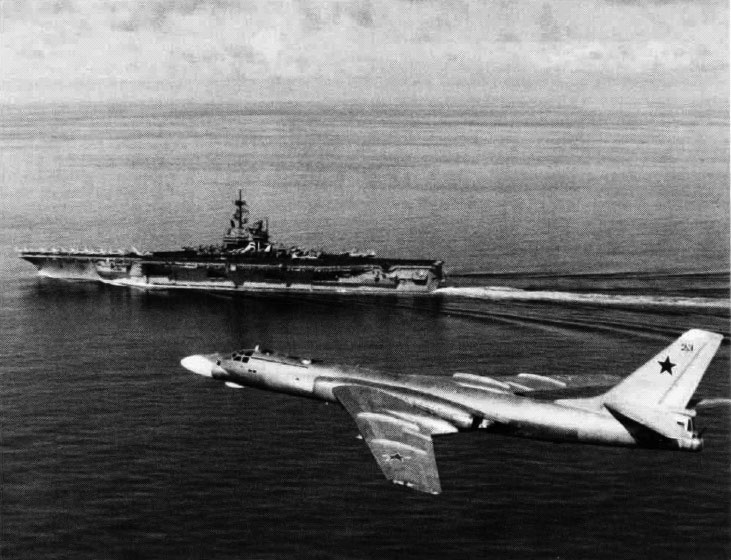
USS ranger shadowed by a Soviet TU-16 in 1989
On 24 July 1987, she received a brand new unit for the first time in the USN, Tactical Electronics Warfare Squadron 131 (VAQ-131) equipped with the brand new Grumman EA-6B Prowler, equipped with AGM-88 HARM missiles. On 19 October 1987 she covered the attack of Iranian Oil platforms as part of Operation Nimble Archer in response to a missile attack on MV Sea Isle City, a Kuwaiti oil tanker. On 3 August 1989 she was further east, rescuing 39 Vietnamese refugees adrift in the South China Sea 80 miles from NAS Cubi Point in the monsoon, by rotation of her SH-3s Sea Kings and Sea Knights after being discovered by an A-6 Intruder.
Operation Desert Storm and retirement
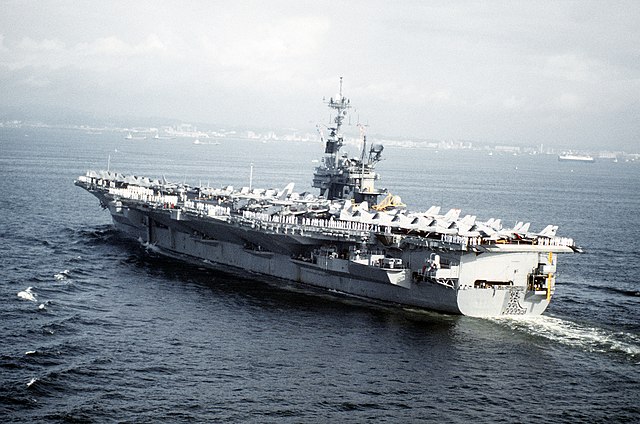
Last visit to Japan, 1992
On 16 January 1991 Operation Desert Storm commenced and 228 sorties from Ranger and Midway were launched in the Persian Gulf, soon joined by USS Theodore Roosevelt, John F. Kennedy, Saratoga, and America, all from the Red Sea added to the 100 Tomahawk missiles from nine ships. One of Ranger’s A-6E Intruders was shot down off the Iraqi coast by AA on 18 January 1991. She was laying MK36 naval mines to blockade the Iraqi naval base at Umm Qasr. She resumed operations with “Battle Force Zulu” (Ranger, Midway, Theodore Roosevelt, America) and on 26 January her EA-6B Prowlers off Bubiyan Island attacked Iraqi tankers with AGM-123 Skipper missiles, sinking one.
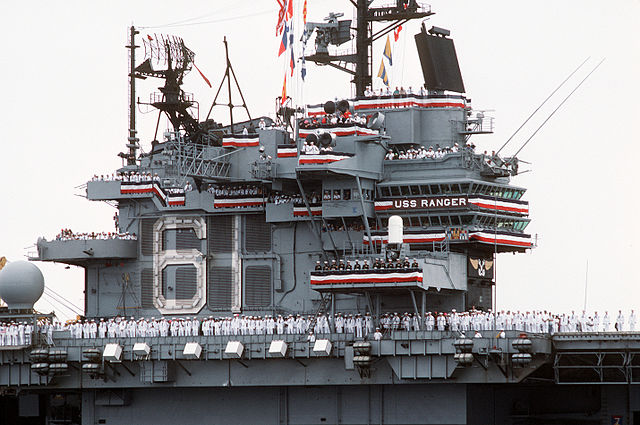
USS Ranger’s island, back from Desert Storm
On 6 February one of her F-14A Tomcats (VF-1) shot down an Iraqi Mi-8 Hip with a Sidewinder missile. The operation caeased soon afterwards. On 21 April 1992 she took part in the WWII 50th-anniversary festivities, re-enacting the Doolittle Raid on Tokyo with two B-25 bombers on board, greeting 1,500 guests to witness these taking off. In June 1991 she visited Vancouver. After preparartions she made her 21st and last WestPac, Indian Ocean deployments from 1st August, entering Yokosuka for upkeep before proceeding to the Persian Gulf (14 September) via Hormuz, relieving Independence. Carrier Air Wing 2 started flying patrol missions to enforce the No Fly zone in southern Iraq, called Operation Southern Watch in coordination with the RAF and RN.
Together with British, and French naval forces she assisted the Russian guided missile destroyer Admiral Vinogradov for an exercise in which a Russian Kamov Ka-27 “Helix” helicopter landed aboard Ranger, a first and last occurrence, unthinkable later. These were the Eltsine years. Departing the Persian Gulf on 4 December 1992 she rushed to the coast of Somalia, participating in the large relief effort (Operation Restore Hope) and later Operation Southern Watch and Operation Restore Hope, receiving for the first time satellite digital pictures, to any US Navy ship at sea. This was the start of a new digital era.
On 19 December 1992, she was relieved by USS Kitty Hawk and went back to San Diego, pending her fate. At that stage, her age was showing. She never benefited from SLEP (the only one stroke by the 1980s budget cuts) and by the early 1990s, her general condition was poor. Due to more recommended cuts her retirement as for Forrestal and Saratoga became an evidence. She was decommissioned on 10 July 1993 (36 years of service and 13 battle stars).
She stayed at the Naval Inactive Ship Maintenance Facility in Bremerton, Washington, a choice subituted to a first planned refit to allow her to stay active until 2002, a FY1994 rejected plan. By September 2010 a not-for-profit USS Ranger Foundation was created to donate the ship and turn her as a museum on the Columbia River (Chinook Landing Marine Park, Fairview, Oregon), but it was rejected in 2012 and the ship was prepared for scrapping from 29 May 2014. Depite a petition to have her preserved as she was at Long Beach harbor, the scrapping proceeded forward as she was awared for a symbolic one cent on 22 December 2014, to International Shipbreaking of Brownsville, Texas, proceeding from 12 July 2015 until 1 November 2017.
 USS Independence CV-62
USS Independence CV-62

USS Independence fitting out at New York NyD while CVS-6 USS Enterpise is awaiting disposal, 22 June 1958.
USS Independence was commissioned on 10 January 1959 after five years of construction at New York NyD, conducted shakedown training under command of Captain R. Y. McElroy. Her first landing-on was done on 2 March 1959. She was designated her homeport, Naval Station Norfolk in Virginia on 30 June 1959. Next came her shakedown ten-week training cruise in the Caribbean, with compatibility tests and for the first time, operation of the Douglas A3D Skywarrior, the largest USN bomber so far with 84,000 pounds (38,000 kg).
Independence’s Atlantic Mediterranean 1960s service
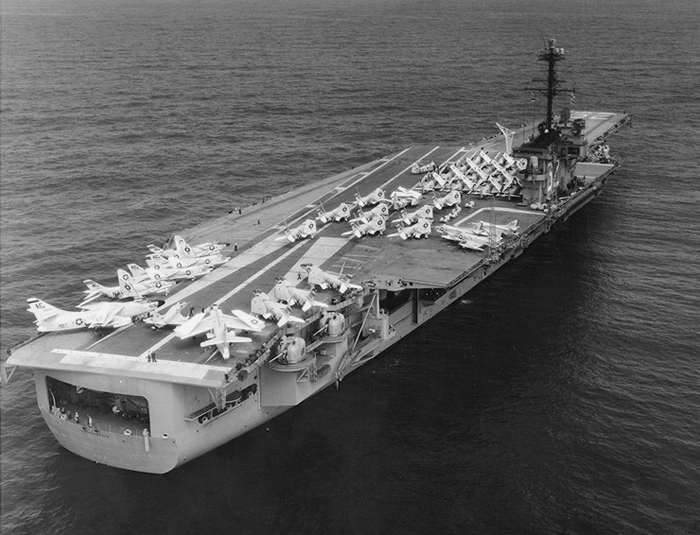
1959 shakedown cruise
USS Independence after extra training off the Virginia Capes departed from her home port on 4 August 1960 for her first Mediterranean Tour of Duty/Deployment (TOD). She was there to add weight in peace-keeping operations of the 6th Fleet in the eastern Mediterranean until back in Norfilk on 3 March 1961. On 4 August 1961 she made her 2nd Med ToD with the 6th fleet until 19 December and 3rd on 19 April 1962 this time to bolster President John F. Kennedy’s stand on Berlin. On 11 October she trained on the the Caribbean Sea and on 24 October was presetn during the 1962 Cuban Missile Crisis, to enforce the blockade off Puerto Rico. Eventually quarantine operationsended and she was back in Norfolk on 25 November, making a refresher training out of Guantanamo Bay.
She departed on 6 August 1963 for a NATO ecercize in the Bay of Biscay, with the Royal Navy and Marine Nationale. She entered the Mediterranean on 21 August, taking part in more NATO exercises, and visited by President Makarios of Cyprus on 7 October 1963. Next she made close cooperation U.S.-Italian exercises in the Adriatic followed by a bilateral U.S.-French exercise where she was “targeted” by French interceptors a a surface action with the French cruiser Colbert abd was back to Norfolk on 4 March 1964.
After training from New York to NAS Mayport in Florida, she departed on 8 September 1964 for NATO exercises in the Norwegian Sea and off France, underway to Gibraltar and back to Norfolk on 5 November, followed by an overhail, which ended in May 1965.
USS Independence in Vietnam
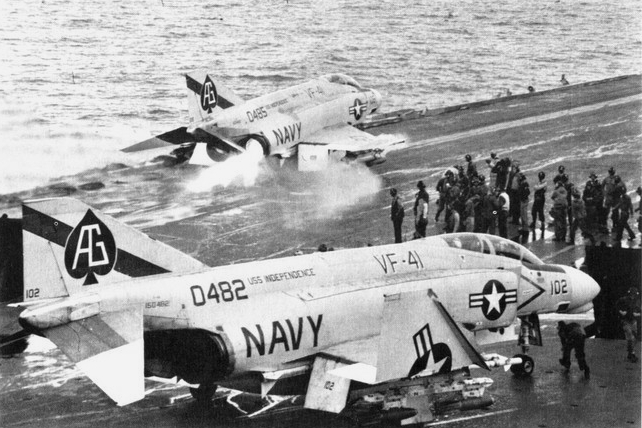
F-4Bs from VF-41 launched from USS Independence in 1965
From there, for seven months and 100 days in the South China Sea, CV 62 was deployed for her tout of duty in Vietnam with the 7th fleet, carrying the Carrier Air Wing 7 and gaining there a Navy Unit Commendation for exceptionally meritorious service (5 June-21 November 1965) when operations were the most intensive. Her air group took part in many coordinated strikes on the Hanoi-Haiphong complex, her planes all successfully evading the most massive SAM defence in aviation history, destroying its assigned surface-to-air missile installation targets. All in all her air group carried out 7,000 sorties, day and night, destroying many valuable military and logistic supply facilities in North Vietnam.
Back to normal operations 1966-1979

USS Independence (CVA-62) underway at sea, circa 1971
Independence after a stop in Norfolk from 13 December 1965 replenished and trained after a well-deserve crew leave. On 4 May 1966 she took part in Operation Strikex and from 13 June was back with the 6th fleet for NATO operations and exercises untim December. She was back with CONUS in early 1967, before returning for an overhaul at Norfolk, leaving on 19 September and by 30 April 1968, back in the Mediterranean for nine-months and back on 27 January 1969.
On 3 September she sailed out of Norfolk for NATO exercises in the North Atlantic (NORLANT), making cross-deckings of Hawker Siddeley Harrier until back on 9 October. She was back in the Med by 23 June 1970 and home again on 31 January 1971, earning the Meritorious Unit Commendation after her service against the PLO (Jordanian crisis). On 25 September 1970 indeed there was a crisis developing in the Middle East and she was put in standby for the evacuation of U.S. citizens and counter a massive Soviet Mediterranean fleet deployment.
VMA-142, -131 and -133 started pilot qualification landings on A-4 Skyhawks on 3 August 1971 and for the first time Marine Corps Reserve squadrons qualified in carrier duty. By September 1971 she departed Norfolk and her crew gained the ‘Blue Nose’ when crossing the Arctic Circle on 28 September. She conducted cross-deck operations with HMS Ark Royal, and via the Channel she reached the Strait of Gibraltar for Mediterranean operations. In May 1973, she hosted President Richard M. Nixon for his annual Armed Forces Day address. Next she was in the Mediterranean and Indian Ocean and until October 1973 as TG 60.1, with TG 60.2 (Franklin D. Roosevelt), and TG 61/62 (USS Guadalcanal) for a possible evacuation in the Middle East (Yom Kippur War), staying off Crete.
In 1974 she departed Norfolk for he new ‘Med Cruise’ with CTG 60.1 and CVW-7 and relieving Franklin D. Roosevelt, Independence and Saratoga. By 8 September 1974 they learned for the bombing of TWA Flight 841 and were soon on the crash site, spending days retrieving remains. On 20 June 1979, Lt. Donna L. Spruill qualified onboard as the first female Navy pilot, on a C-1A Trader.
1980-1990, SLEP and Pacific service
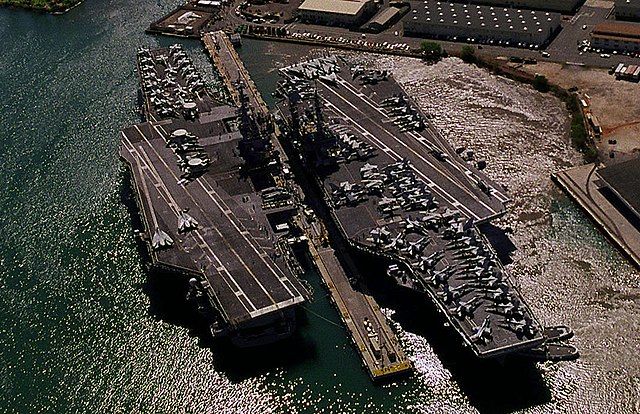
USS Independence and Kitty Hawk in Pearl Harbor
On 19 November 1980, she carried CAW-6 (Carrier Air Wing Six) to the Indian Ocean escorted by the missile cruiser USS Harry E. Yarnell at “Gonzo Station” as Pdt. Reagan taking office wanted the Iranian Hostages being freed. She later transited the Suez Canal and completed a 204 days deployment at sea. She was in the Persian Gulf to reiforce Nimitz TF under command of Thomas E. Shanahan. She then returned south and through the Indian Ocean to Perth and Fremantle in Western Australia, visited on 2-7 February. In 1982 she was part of the multinational peacekeeping force in Lebanon. Forrestal, Independence, Dwight D. Eisenhower, John F. Kennedy stayed as a show of power in the eastern Mediterranean Sea until departing back to Norfolk.
In late October 1983, USS Independence’s battle group 4 was assigned to the 2th Fleet, becoming TG 20.5, deployed to support the Invasion of Grenada deployed from 25 October 1983. Later that year she was back in Lebanon that same year and her air group conducted air strikes against Syrian positions. On 17 February 1985 she was in Philadelphia NyD doe an overhaul and modernization called SLEP, expected to extend her active life for 15 more years. It was over and she sailed on 15 August 1988 from Norfolk to change home port, crossing the Cape Horn, at NAS North Island, San Diego, California. She arrived on 8 October.
She starred briefly in the movie Intruder (1991) in November 1989. In June 1990 she carried Carrier Air Wing 14 for her first WESTPAC. On 2 August as Iraq’s invaded Kuwait she led TG 800.1 (escorted by USS Jouett, CG-29) to take part in Operation Desert Shield, arriving on station in the Gulf of Oman on 5 August and remaining on station for 112 days until back to San Diego on 20 December. She was given a new home port from 11 September 1991, Yokosuka in Japan, with Carrier Air Wing 5. She became the only permanently forward-deployed US CV, and acted as local flagship for Carrier Group Five CiC.
On 23 August 1992 under Captain Carter B. Refo, she was back in the Persian Gulf to enforce an Allied ban on Iraqi flights and surveillance missions in southern Iraq and to enforce Resolution 688 related to the repression of the Shiite population in southern Iraq. Operation Southern Watch mobilized 20 Navy aircraft from CVW-5 (USS Independence), and thus, became the carried became most battle experienced of the entire US Navy fleet, awarded other distinctions on 30 June 1995, like the rarely attributed Revolution-era First Navy Jack “Don’t Tread on Me” flag, that she flew fro her bow until decommission.
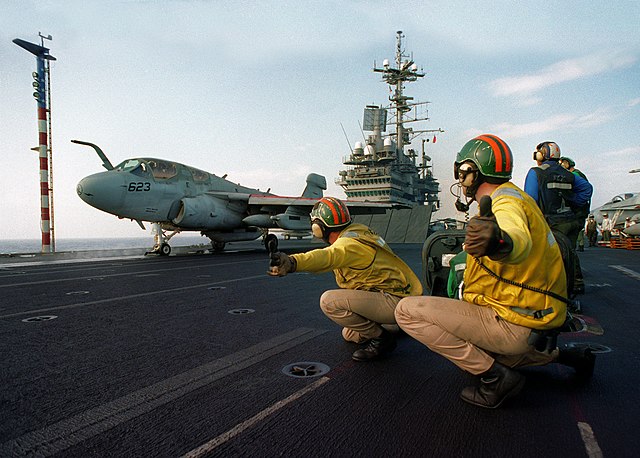
Grumman EA-6B Prowler (VAQ-136) launched from USS Independence, 13 March 1996
By November 1995, she was back in Japan as Operation Southern Watch ended. She was present newt in the Third Taiwan Strait Crisis, joined by USS Nimitz when China was growingly agressive towards Taiwan. She was back to Yokosuka in April 1996, visited by President Bill Clinton during his state visit. In 1997 she made a 4-month deployment for several exercizes with the JMSDF, stopping in seven ports and notably Guam, first aircraft carrier in 36 years. Port Klang, Malaysia, Hong Kong, and back in the Persian Gulf in January 1998 as negotiations between the UN and Iraq stalled. In Yokosuka she was relieved by USS Kitty Hawk and returned home. She was decommissioned in ceremonies at the Puget Sound Naval Shipyard, Bremerton, Washington, 30 September 1998. She had been in active servive for 39 years, 9 months and 20 days while the “Don’t Tread on Me” Jack was transferred to USS Kitty Hawk.
After decommission and 5.5 years mothball she was stricken for good on 8 March 2004, being cannibalized along the way for the Kitty Hawk-class aircraft carriers, and Nimitz-class USS George H.W. Bush (anchors). As for her sisters discussions to convert her as a museum ship led to nowhere but by April 2004, Navy officials wanted her part of 24 decommissioned ships to be sunk as artificial reefs. Instead she was to be dismantled as USS Constellation and towed after being sold on 26 January 2012 from Puget Sound Naval Shipyard to Brownsville, Texas, by International Shipbreaking Limited in 2017, until 2019. Her badge featured “liberty bell” at Philly’s Old State House Bell.


 Latest Facebook Entry -
Latest Facebook Entry -  X(Tweeter) Naval Encyclopedia's deck archive
X(Tweeter) Naval Encyclopedia's deck archive Instagram (@navalencyc)
Instagram (@navalencyc)





 French Navy
French Navy Royal Navy
Royal Navy Russian Navy
Russian Navy Armada Espanola
Armada Espanola Austrian Navy
Austrian Navy K.u.K. Kriegsmarine
K.u.K. Kriegsmarine Dansk Marine
Dansk Marine Nautiko Hellenon
Nautiko Hellenon Koninklije Marine 1870
Koninklije Marine 1870 Marinha do Brasil
Marinha do Brasil Osmanlı Donanması
Osmanlı Donanması Marina Do Peru
Marina Do Peru Marinha do Portugal
Marinha do Portugal Regia Marina 1870
Regia Marina 1870 Nihhon Kaigun 1870
Nihhon Kaigun 1870 Preußische Marine 1870
Preußische Marine 1870 Russkiy Flot 1870
Russkiy Flot 1870 Svenska marinen
Svenska marinen Søværnet
Søværnet Union Navy
Union Navy Confederate Navy
Confederate Navy Armada de Argentina
Armada de Argentina Imperial Chinese Navy
Imperial Chinese Navy Marinha do Portugal
Marinha do Portugal Mexico
Mexico Kaiserliche Marine
Kaiserliche Marine 1898 US Navy
1898 US Navy Sovietskiy Flot
Sovietskiy Flot Royal Canadian Navy
Royal Canadian Navy Royal Australian Navy
Royal Australian Navy RNZN Fleet
RNZN Fleet Chinese Navy 1937
Chinese Navy 1937 Kriegsmarine
Kriegsmarine Chilean Navy
Chilean Navy Danish Navy
Danish Navy Finnish Navy
Finnish Navy Hellenic Navy
Hellenic Navy Polish Navy
Polish Navy Romanian Navy
Romanian Navy Turkish Navy
Turkish Navy Royal Yugoslav Navy
Royal Yugoslav Navy Royal Thai Navy
Royal Thai Navy Minor Navies
Minor Navies Albania
Albania Austria
Austria Belgium
Belgium Columbia
Columbia Costa Rica
Costa Rica Cuba
Cuba Czechoslovakia
Czechoslovakia Dominican Republic
Dominican Republic Haiti
Haiti Hungary
Hungary Honduras
Honduras Estonia
Estonia Iceland
Iceland Eire
Eire Equador
Equador Iran
Iran Iraq
Iraq Latvia
Latvia Liberia
Liberia Lithuania
Lithuania Mandchukuo
Mandchukuo Morocco
Morocco Nicaragua
Nicaragua Persia
Persia San Salvador
San Salvador Sarawak
Sarawak Uruguay
Uruguay Venezuela
Venezuela Zanzibar
Zanzibar Warsaw Pact Navies
Warsaw Pact Navies Bulgaria
Bulgaria Hungary
Hungary

 Bundesmarine
Bundesmarine Dutch Navy
Dutch Navy Hellenic Navy
Hellenic Navy Marina Militare
Marina Militare Yugoslav Navy
Yugoslav Navy Chinese Navy
Chinese Navy Indian Navy
Indian Navy Indonesian Navy
Indonesian Navy JMSDF
JMSDF North Korean Navy
North Korean Navy Pakistani Navy
Pakistani Navy Philippines Navy
Philippines Navy ROKN
ROKN Rep. of Singapore Navy
Rep. of Singapore Navy Taiwanese Navy
Taiwanese Navy IDF Navy
IDF Navy Saudi Navy
Saudi Navy Royal New Zealand Navy
Royal New Zealand Navy Egyptian Navy
Egyptian Navy South African Navy
South African Navy






























 Ukrainian Navy
Ukrainian Navy dbodesign
dbodesign
To whom it may concern:
I’m writing a piece of fictional history. My protagonist is going from China Lake to fly FJ-3’s in VF-84 stationed aboard USS Forrestal in October of 1956. The question would be where was VF-84 then? Of course that would be answered if we knew where Forrestal was then. Your assistance in this matter would be greatly appreciated. This fairly minor stumbling block has proven unanswerable for me thus far; perhaps someone can suggest how I may find out. Thank you.
Hello Kendall
Better would be to simply check for the wikipedia page on the VF-84, service on one or several ships over time should be listed; And you have references at the bottom.
Cheers,